BoatNews.com

Build your own mini catamaran, a guide for amateur builders
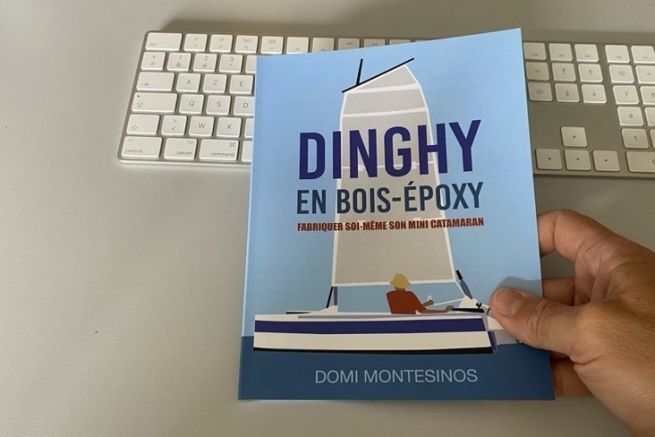
Building a small catamaran that can be used as a dinghy or even as a small dinghy: this is what this little booklet offers, with all the plans to help you achieve this. If you are tempted, Dominique will accompany you. Follow the guide!
Dominique is an autodidact with a passion for everything. He has built his life on multihulls. He also likes to tell it in several books ( find here Dominique's books ) when he's not tinkering with his boat ( find here Dominique's choices for a power catamaran ). When he has to think of a dinghy for his latest catamaran , it is naturally that he imagines a dinghy with 2 hulls.
He therefore sat down at his drawing board (the one in the saloon, of course) and designed a 3 m long epoxy plywood dinghy that would be stable and voluminous without being too heavy. In his little guide "Dinghy in Epoxy Wood", he explains how to build this dinghy . A construction within the reach of an amateur.

The book is divided into 2 parts: the first one tells and explains the whole construction (24 pages). The second part includes all the plans as well as some photos of the construction and the annex in its final version.
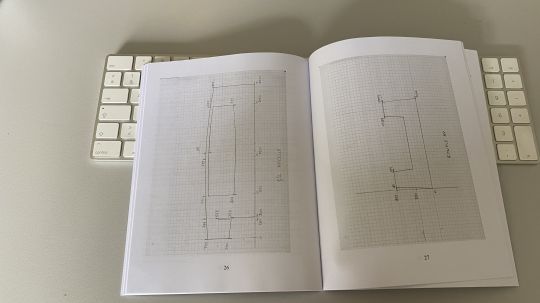
With this little book in hand, you will be able to build your own annex. However, you will have to reread the text several times to fully understand the assemblies and the different steps. Some key elements are also missing, such as the final technical data sheet of the annex (length, width, weight...). Finally, the builder who would like to start the project will have to think carefully about how to procure materials. No data on the number of sheets of plywood or the quantity of resin are provided. Dominique warns that this adventure is "primarily aimed at experienced handymen".
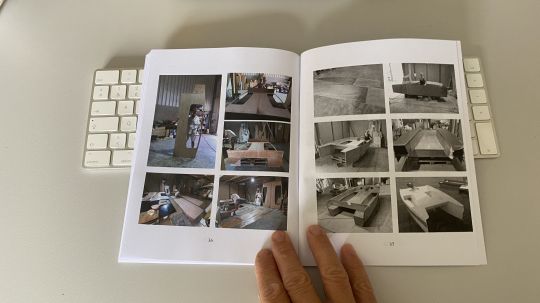
The idea of proposing an annex under amateur construction is a great idea. Dominique's realization with 2 couples in place of beam for rigidity is good. The plans seem precise and the ribs well detailed. It just lacks a little depth (and detail) to help a builder who would not be as comfortable as Dominique is in the use of composite materials.
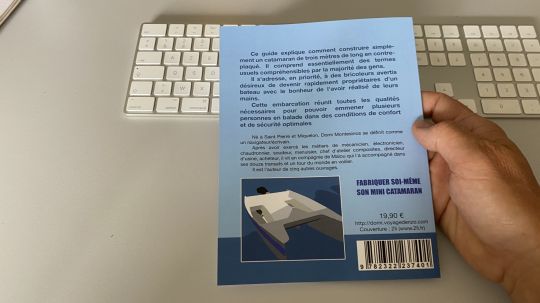
Dinghy in wood-epoxy - Build your own mini catamaran
- Domi Montesinos
- 17 x 21.9 cm
- 19.90 euros
[email protected]

The Best Advanced Build System in the World
The schionning advanced build system are one of the simplest ways to build your own boat, or have a custom design built faster and more accurately by a professional. utilising duflex panels with a balsa core, large sheets are joined on their long edge to form full length hull panels, bulkheads etc similar to a giant jigsaw puzzle. once you release the tabs, your full size pieces are ready to be assembled., a pre-cut advanced build system does not only benefit the home builder, but streamlines a professional build as quantities are accurate and wastage is minimised. when having a vessel built overseas, a kit reduces the chances of local materials not being available, or delays during your project, and ensures there are no mistakes., read on below to gain a more solid understand of how the schionning advanced build system go together, where are you building.
Schionning Designs is partnered with a number of leading composite manufacturing companies with varying CNC capabilities, as well as supplying resins, hardeners, cloths and fillers. Our partners are located in different parts of the world, so where you are planning to build your boat will have an impact on which composite company is best to supply your kit.
Listed below are our composite manufacturering partners, ATL Composites located in Australia, VDL Composites located in Germany, and PBT Technologies located in South Africa.

ATL Composites (Australia)

VDL Composites (Germany)

PBT Composites (South Africa)
Starting the process.
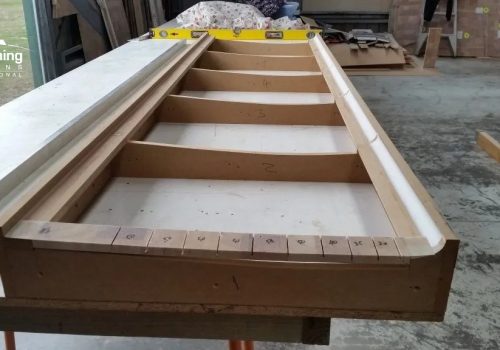
THE KIT PROCESS
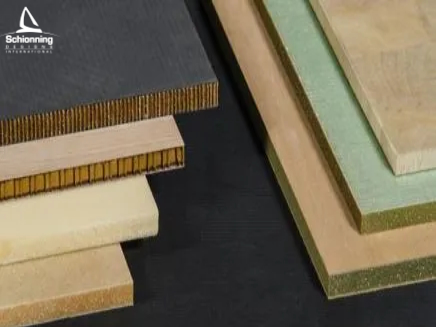
MATERIAL CHOICES

TECHNICAL INFORMATION

RECOMMENDED EQUIPMENT

How to Build a Catamaran Boat? (Step-by-Step Guide)
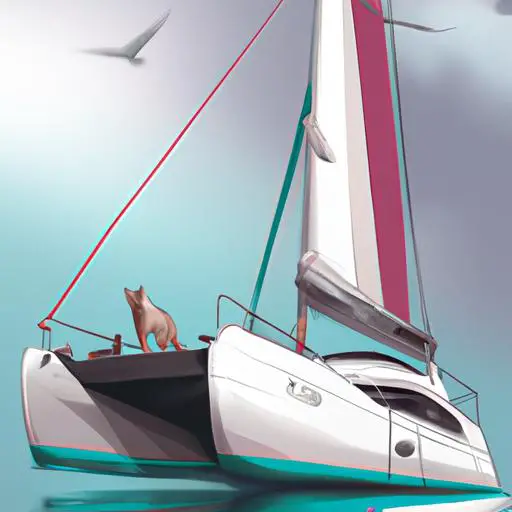
Building a catamaran boat from scratch is a rewarding and challenging endeavor.
It takes a combination of skill, dedication, and hard work to craft a seaworthy vessel.
In this step-by-step guide, you’ll learn how to design and size your catamaran, gather the necessary materials, cut and assemble the pieces, lay fiberglass and apply epoxy, make finishing touches, add hardware and paint, and rig the boat.
With the right tools, planning, and patience, you can make your dream of sailing in a catamaran a reality.
Table of Contents
Short Answer
Building a catamaran boat requires a lot of patience and skill.
The first step is to choose the right materials for the hull, such as fiberglass, wood or aluminum.
Then, you will need to build the frame of the boat, which includes the crossbeams and the main hull.
After that, you will need to install the decking, the rigging, and other components.
Finally, you will need to paint and varnish the boat, as well as install the outboard motor and other accessories.
Design & Size Considerations
When it comes to building a catamaran boat from scratch, the first step is to determine the design and size of the boat.
This should take into account the intended use of the boat, such as sailing, fishing, or leisurely cruising.
The size of the boat will depend on the number of passengers and the type of activities the boat will be used for.
For instance, a larger boat may be needed if passengers will be standing or participating in watersports.
The design of the boat is also important and should be chosen based on the intended use.
If you are looking to build a sailboat, you will need a design that is optimized for sailing.
On the other hand, if you are looking to build a fishing boat, you will need a design that is optimized for fishing.
There are a wide variety of boat designs available, so it is important to research and choose the one that best suits your needs.
In addition to the design and size, you will also need to consider the materials used for construction.
The most common materials for building a catamaran boat are wood, fiberglass, and epoxy.
Each material has its own advantages and disadvantages, so it is important to research them and determine which one is best for your project.
Finally, you will need to consider the cost of the project.
Building a catamaran boat from scratch can be a costly endeavor, so it is important to have a budget in mind before you begin.
The cost will depend on the type of materials used and the complexity of the design.
It is also important to factor in the cost of any tools that may be needed for the project.
By taking into account the design and size, materials, and cost of the project, you can be sure to build a catamaran boat that meets your needs and budget.
With the right amount of patience and attention to detail, you can build your own catamaran boat in no time.
Gathering Materials

Gathering the materials needed to build a catamaran boat from scratch can be a daunting task, but it is essential for creating a sturdy and safe vessel.
Before starting the building process, it is important to have an accurate and detailed plan for the boats design and size.
Once a plan is in place, it is time to begin sourcing the necessary materials.
The most common materials used to construct a catamaran boat are wood, fiberglass, and epoxy.
When choosing wood, it is best to select a species of timber that is strong and durable, such as mahogany, teak, or cedar.
Additionally, the wood should be clear and free of knots, splits, and other defects.
Fiberglass is a lightweight fabric that is resistant to water and provides additional strength to the boats hull.
Epoxy is a waterproof adhesive that is used to seal the boat and ensure that it is watertight.
It is important to ensure that the materials are of high quality, as this will help to ensure the boats longevity.
Additionally, it is important to purchase the necessary materials in the correct amount and size.
Too little or too much of a material can be a costly and time-consuming mistake.
Finally, it is important to keep any leftover materials for future repairs or modifications.
With the right materials gathered, the next step is to cut the wood and begin the assembly process.
Cutting & Assembly
Cutting and assembly are the most important steps when it comes to building a catamaran boat from scratch.
The first step is to decide the design and size of the boat.
This will determine the type of materials you need to gather and the amount of effort that needs to be put into the project.
After deciding on the design and size, you will need to cut the wood to fit the design.
This includes cutting the wood to the desired size, as well as cutting any additional pieces that may be needed to complete the design.
It is important to ensure that all the pieces fit together correctly and securely, as any mistakes could lead to a weak boat.
Once the wood has been cut, it is time to assemble the pieces together.
This involves attaching the pieces together with glue, screws, and nails, and ensuring that the pieces fit together securely.
It is important to be careful and patient when assembling the pieces, as any mistakes could result in a weak and unstable boat.
Once the frame is ready, it is time to lay the fiberglass, and apply the epoxy to seal the boat.
This is an important step, as it will make sure that the boat is waterproof and durable.
Finally, you can add the finishing touches, such as the hardware, paint, and rigging.
With the right amount of patience and attention to detail, you can have your own custom catamaran boat in no time.
Laying Fiberglass & Applying Epoxy

When laying the fiberglass and applying epoxy, it is important to take your time and be precise.
Fiberglass and epoxy are key components of a catamaran boat, as they provide the strength and waterproofing necessary to keep the boat afloat.
Start by laying the fiberglass over the frame of the boat.
Make sure to cut the fiberglass to size and overlap the edges for a strong seal.
Once the fiberglass is in place, mix the epoxy and begin to apply it.
It is important to apply the epoxy in a thin, even layer to ensure a proper seal.
Make sure to move the epoxy around to get it into all the nooks and crannies of the boat.
Allow the epoxy to cure and then you can begin to add the finishing touches.
Finishing Touches
Once the frame of the catamaran boat is built, it is time to add the finishing touches.
This includes adding the necessary hardware, painting, and rigging the boat.
Hardware: Before adding the hardware, it is important to ensure that the frame is stable and secure.
Add the appropriate hinges, screws, and nails to the frame.
Make sure that the screws and nails are the correct size and do not exceed the recommended load capacity of the frame.
Painting: Once the hardware is added, it is time to paint the boat.
Choose a paint that is suitable for the materials used in the construction.
Make sure that the paint is applied evenly and that the frame is completely dry before applying the next coat.
Rigging: The last step is to rig the boat.
This involves attaching the sails, running rigging, and standing rigging to the masts and booms.
Make sure that the rigging is properly tensioned and secured.
Once all of these steps are complete, your catamaran boat is ready to sail.
Hardware & Paint

The last step in building a catamaran boat is to add the hardware and paint.
This step is often the most rewarding, as it is the finishing touch.
Depending on the design of your boat, there are various types of hardware you may need.
Some of the most common items are cleats, winches, fasteners, and decking.
After selecting the required hardware, you will need to install them on the boat.
It is important to use the correct type of screws and bolts, and to secure them tightly.
Once the hardware is installed, it is time to apply the paint.
The type of paint and color you choose will depend on the design of your boat.
It is important to use a high-quality marine grade paint that is designed to handle the extreme environment of the ocean.
If you are up to the challenge, you can add some custom artwork or detail to your catamaran boat.
Adding the hardware and paint is the final step in building a catamaran boat.
With patience and attention to detail, you can create a beautiful and unique boat that will last for many years.
Be sure to take your time and enjoy the process of constructing your own boat.
Once you have finished the frame, fiberglass, and epoxy of your catamaran boat, you will need to move onto the rigging.
This is a crucial step in the construction process, as it will keep your boat safe and secure on the water.
When rigging a catamaran, there are a few key components that must be taken into account.
First, you will need to determine the type of rigging you will be using.
Typically, catamarans use a combination of standing and running rigging.
Standing rigging consists of cables and lines that stay in a fixed position to provide stability and strength to the boat, while running rigging consists of lines that are used to adjust the sail and mainsheet.
Additionally, you will need to choose the right type of rope and hardware for your rigging setup.
The rope should be strong and durable, and the hardware should be made of stainless steel and be corrosion-resistant.
Once you have chosen the type of rigging and hardware, you can start assembling the rigging lines.
This process involves carefully measuring and cutting the lines to the proper lengths, and then attaching them to the mast and boom.
Depending on the type of rigging setup, you may also need to attach the lines to the hulls and deck.
It is important to inspect the rigging lines and hardware regularly to ensure that everything is secure and in proper working order.
Rigging a catamaran boat can seem like a daunting task, but it is essential for the safety and comfort of your vessel.
With the right tools, materials, and attention to detail, you can successfully and safely rig your catamaran boat.
Final Thoughts
Building a catamaran boat is a rewarding experience that requires patience and attention to detail.
With the right plan, materials, and steps, you can build your own boat in no time.
Now that you know the basics of how to build a catamaran boat, why not grab your tools and get started on your very own project? With the right motivation and dedication, you can make your dream of owning a catamaran boat a reality.
James Frami
At the age of 15, he and four other friends from his neighborhood constructed their first boat. He has been sailing for almost 30 years and has a wealth of knowledge that he wants to share with others.
Recent Posts
When Was Banana Boat Song Released? (HISTORICAL INSIGHTS)
The "Banana Boat Song" was released in 1956 by Harry Belafonte. This calypso-style song, also known as "Day-O," became a huge hit and remains popular to this day for its catchy tune and upbeat...
How to Make Banana Boat Smoothie King? (DELICIOUS RECIPE REVEALED)
To make a Banana Boat Smoothie King smoothie at home, start by gathering the ingredients: a ripe banana, peanut butter, chocolate protein powder, almond milk, and ice. Blend the banana, a scoop of...
Time For a Catamaran Adventure
Isn't Time For Yours?
Building Your Own Catamaran
Building your own catamaran is another option to getting into your own boat. In this page we will go over the advantages, considerations, and a detailed history and journal of our boat-building adventure with Light Wave . We hope this will give you a clear picture of what lies ahead if you go this route, including:
- Construction methods
- 9 essential design features
- Review of the four leading catamaran designers for home builders
- Construction times
- Budget: How much did it cost to build a basic cruising catamaran?
- Layout of our catamaran, LightWave , and lots of pictures
- Carllie’s article from September 2000 Multihulls Magazine: “The Boat Builder’s Wife “
- Equipment outfitting
- Radio and communication outfitting
- Dinghy selection and considerations
- Having a boat custom-built for you
| |
Because of the huge dollars needed to buy a new or even a used catamaran, we would never have gotten a catamaran if we hadn’t built it ourselves.
Let’s start by saying that building any type of larger boat, especially a catamaran, can be one of the most intellectually and physically challenging things you will ever do.
It has been said that building a large boat is the closest a man can come to giving birth to a baby. In other words there is going to some discomfort and pain along the way; you will question yourself on whether this was such a good idea; it’s very difficult to reverse the decision; and though friends will support you, you will be on your own most of the time with your significant other if he/she is game.
Know your boat
You will intimately know every part of your boat. You will know where every wire, hose, bolt, bulkhead, rib, and support is because you installed them!
Pride of ownership
We have often thought what it would be like to just buy a boat from a manufacturer, and know that while owners who have spent a lot of cash (or future life to pay off the lien) their often possessive and competing-with-the Joneses could not begin to compare to our quiet glow of happiness and akinship we feel with Light Wave .
Our boat is like part of the family. So much time was spent on her that we have a major emotional investment. Every time we see our vessel – from a distance at anchor or approaching her in our marina, we say, “What a pretty boat! I can’t believe we built it!” Then that sense of accomplishment settles back in and we feel we have indeed earned the privilege of all of the beautiful experiences we have had sailing, cruising, exploring the beautiful BC Coast and much further a field (or should we say “an ocean”?).
You will be able to pay for the materials as you go and “donate” your time to the cause.
Get a newer design
Many of the production boats that are out there are designs of many years ago because the manufactures have to recoup their capital investment on the mold and production setup. When you build your own you have much newer designs to draw from.
Details on Our Boat Building Adventure
We had sailed our first boat Wave Dancer for five years and had many adventures on the British Columbia coast. In May 1996, I had just returned from a little one-week solo trip in the Gulf Islands of BC when I bought the book, The Cruising Multihull by Chris White (Future link to book review on our web site).
This is the book that got me going (Carllie was not yet convinced). I must have read it a half dozen times over the next 6 months, each time becoming more convinced that this was the way to go for our next boat. It was really still pre-internet web site days so I wrote to all the designers that were listed in the back of the book. Over the next several weeks packages of information started appearing in the mailbox (there is just something about getting packages in the mail – I guess it’s the anticipation). I would pour over these preliminary printed pages with pictures and accommodation layouts. Next, I put a few dollars down to buy the information packages and study plans from the top prospects.
I waited patiently for the study plans. It was like the night before Christmas when I was kid. Oooh the wait! Finally they came, and again I carefully scrutinized the next level of detail. Things were getting a little more serious. The top contenders were:
- Richard Woods
- Chris White
- James Wharram
Click here to read my comments and reviews on their catamaran designs as well as those of Jeff Schionning.
I remember initially drooling over the Atlantic 42 by Chris White, still one of my favorite designs. It seemed to be so seaworthy (by the way if I run into about $800,000 USD any time soon, I am going to buy an Atlantic 55). The most important piece of advice that came out of the material was from Richard Woods:
“Build the smallest boat you‘d be happy with it.”
Axiom #1: The hours to build a catamaran is in almost in direct proportion to its weight.
Which brings us to Axiom #2:
Axiom #2: It takes about 1 hour to create 1 pound of finished boat.
In our case we spent 3,500 hours ( click here for full details on the construction hours ) to build a 4,000 lb. boat (just a little less than 0.9 hours per pound). If a boat’s empty weight is 8,000 lbs., it will probably take about 6,000 hours to build.
When you think about it, you can only mix and handle so much material per hour. More boat weight, more material, more hours. Sure there are some economies of scale on a bigger boat, but usually the systems become more complex and these take longer to install.
This decision process took 8 months and I figured we’d launch in 6 months. It was now January of 1997. Little did we know it would be 26 months and 3,500 hours between the two of us until we launched on June 5, 1999. We ordered the full plans and we were off and running.
We were ready to build, but where would we start the process? First of all, we live in a tiny 480 sq. ft. apartment in Vancouver. Back-yard building wasn’t exactly an option so I found a small garage nearby that we rented for 5 months.
After about 4 months in the garage, I had made all the small parts and it was time to build the hulls. This meant that we had to go larger facilities. We found space at Shelter Island Marina and Boatyard in Richmond. This is the biggest boat yard in the Vancouver area with dozens of commercial and private projects, big and small, under way.
We were out of money by then, so we sold our first boat so we could buy resin and fiberglass. It was a traumatic time as we said goodbye to our beloved Wave Dancer . We were now committed. We than had all the foam for the hull cores, barrels of resin, and huge rolls of matting and roving needed for the fiberglass skins delivered to our “domed stadium”. We kicked ourselves many times that we didn’t take a picture of this raw material stacked in one corner of the empty shed, so we could later show “before” and “after” photos. It was time to build the hulls.
Over the next several months we proceed to join the hulls with the beams I had built in the garage, and then to install the cuddy cabin, cockpit, and decks. By the spring of 1998, it was staring to look like a catamaran. Through the spring and summer of 1998, we continued with the major structural components: mini-keels, hatches, stairs, and interior. Then we went on to the very laborious work of fairing the boat before painting. Don’t under estimate that job!
By October 1998 we were ready to prime the boat and start painting. I really thought this would go quickly. I forgot that I would have to do two more complete sandings to sand off and finish the two layers of primer application. In addition we had to fill countless pinholes – a laborious process somewhat like hiking up a mountain – each time you get to what you think is the top, you see another summit!
The boat seemed to get bigger and bigger. Believe me, there is a lot of surface area on a catamaran. I clearly remember that last sanding: I had reached the end of my physical and mental endurance – I was exhausted. I was ready to move on to the next phase – any phase but more sanding!
We now started spray-painting the hulls bright yellow. It was around this time we decided on our boat name of Light Wave . The painting took over a month: the hulls being the easy part, it was the topsides, the nonskid, and all the masking and prep that seemed to take forever. Happily, the worst of the dust was gone.
By March 1999 we were in the home stretch. The center bridge deck cabin was completed so we took a week off from our paid jobs and lived on the boat in the shed so we could work all day and not waste time commuting. March, April and May were frantic months as we finished all the final touches: engine installation, rudders, windows, deck fittings, electrical, plumbing, mast, and rigging. See our outfitting page (for more details on what we picked and why, and things we would do differently now.
Initially, our electronic systems were relatively basic but included GPS and autopilot see the following link for all our electronic outfitting choices and reasoning for more details.
It was May 22, 1999 and we decided that Saturday, June 5th would be “Launch Day” so we could send invitations to all of our friends. On the Friday night before Launch Day, we still had a number of final things to do, many of them outside. Unfortunately it was pouring rain. We were tired and very wet but the boat had to go into the water next day so we persevered on till everything was ready.
The moment of truth came as Light Wave was lowered into the water. While still in the slings of the Travelift, I jumped aboard to check for leaks. Of course there weren’t any! More food and laughs and tours of the boat for all attending. It was a great day.
Emotionally drained that night, we slept in Light Wave in the water for the first time. It was another week before we actually went out for our first trip as we had to sell the shed, setup sails, and install some final deck hardware.
To sum it up, building a catamaran was a great experience. We learned a lot. Carllie and I grew closer together through it all. We had a great time doing it. We had a beautiful catamaran to show for it. Now it was time for a catamaran adventure !
| |
| Ed Horstman designed TRIMARAN and CATAMARAN plans are drawn for the first time builder. Plans are concise and clearly drawn so the builder can easily follow each building step. Designs are continuously updated with your input and new ideas. Plans include full size patterns to 63'. The larger TRI's and CAT's have full radius hulls.With no lofting you build right away. The DESIGNER'S book TRIMARAN and CATAMARAN CONSTRUCTION is part of the plans (over 21') and covers all phases of construction. Plans are leased to build ONE boat, NO time limit. Tri-Star designs are proven designs, sailing the seven seas since 1964. Free consultation is provided to the original non-professional builder till he or she is sailing the seven seas. All boats may be built with flared hulls, with the exception of the TRI 25, TRI 26MT, CAT 27PC and the CAT 27. A DESIGN FEE for customer modifications to stock plans. Small, Fast Catamaran Design
TRI-STAR CAT 14 Plans $ Slightly Larger, Fast Catamaran Design TRI-STAR CAT 19 Plans $ Trailerable, Fast Catamaran Design with berthing areas TRI-STAR CAT 27 PC Study Plans $ TRI-STAR CAT 27 Study Plans $
TRI-STAR CAT 34 Plans $ CAT 36 designed as a spacious, fast enjoyable sailing cataramarn with accomodations found only on much larger yachts.
TRI-STAR CAT 36 Study Plans $
TRI-STAR CAT 38 Study Plans $
TRI-STAR CAT 41 Study Plans $
TRI-STAR CAT 51 Study Plans $ TRI-STAR CAT 55 Study Plans $ TRI-STAR CAT 55 Plans $ | ||||||||
|
| | | | |
| The designs where there is a YELLOW BACKGROUND are the designs for which CUTTING FILES are available. |
|
|
|
|
|
|
Boat is well up to expectations. Have experienced some heavy weather and are impressed by the stable ride especially to windward. Judy can still use the vacuum cleaner at 30 knots + She is alo impressed by her washing machine and dishwasher not to mention the deep freeze !! Large Rig but easily handled by 2 persons. |
|
|
|
|
|
LATEST NEWS FROM OTHER BUILDERS
RETURN TO HOME / INDEX PAGE
Small Sailing Catamarans: The Ultimate Guide
by Emma Sullivan | Aug 14, 2023 | Sailboat Gear and Equipment

Short answer: Small sailing catamarans
Small sailing catamarans are multi-hulled boats that offer stability, speed, and ease of handling. They typically have two parallel hulls connected by a platform and are designed for recreational or racing purposes. Popular among sailors due to their maneuverability and shallow draft, they are suitable for both inland and coastal waters.
The Beauty of Small Sailing Catamarans: Why They’re Perfect for Adventurers
Are you an adventurer at heart, longing to set sail and explore the vast depths of the ocean ? If so, we have just the vessel that will capture your imagination and ignite your sense of wanderlust – small sailing catamarans. These marvels of engineering offer a unique sailing experience like no other, making them the perfect choice for those seeking both adrenaline-pumping escapades and tranquil moments at sea.
What makes small sailing catamarans so enthralling is their remarkable combination of stability, speed, and space. Unlike their monohull counterparts, which tip precariously with every gust of wind, catamarans gracefully slice through the water with elegance and poise. Their dual hull design effortlessly balances weight distribution, providing unparalleled stability even in rough seas. This ensures a smoother ride and allows adventurers to indulge in exciting activities without compromising safety.
Speaking of thrills, these nimble vessels possess an inherent need for speed – a characteristic that perfectly suits adventure enthusiasts who crave excitement on the open waters . With their lightweight build and low-drag hull design, small sailing catamarans are designed for rapid acceleration. Imagine skimming across waves at exhilarating speeds as you feel the salty mist caress your face; it’s an experience that truly elevates adrenaline levels to new heights!
But don’t let their penchant for speed fool you – these catamarans also cater to those yearning for serene moments amidst nature’s grandeur. When you have had your fill of fast-paced adventures, simply anchor in a secluded bay or sandy cove to relish peaceful sunsets or immerse yourself in snorkeling adventures beneath crystal-clear waters. The ample deck space offered by small sailing catamarans allows adventurers to bask in the serenity surrounding them while indulging in much-needed relaxation.
One might ask: what about onboard amenities? Small sailing catamarans boast of clever and innovative storage solutions that make them an adventurer’s dream. From hidden compartments to specialized equipment storage areas, these vessels are designed to accommodate all the gear an explorer could possibly need. Whether you’re a scuba diver with tanks and fins or a kayaker seeking new waterways to conquer, rest assured that your equipment will be stowed efficiently on board.
In addition, small sailing catamarans offer spacious cabins for overnight trips or long expeditions – a welcome respite from the elements after an adrenaline-filled day at sea. With comfortable sleeping quarters and well-appointed interiors, adventurers can enjoy a good night’s rest as they prepare for another day of unforgettable conquests.
The versatility of these stunning vessels also opens up opportunities for exploration in shallow waters unreachable by larger boats. The shallows hold their own charm with vibrant coral reefs teeming with exotic marine life waiting to be discovered. Small catamarans’ reduced draft allows adventurers to venture where others cannot, granting unrivaled access to unspoiled paradises that remain hidden to most.
So, if you’re an intrepid soul ready to embark on thrilling escapades on the high seas without compromising on comfort and stability, look no further than small sailing catamarans. These magnificent creations combine performance, resilience, and adventure into one breathtaking package – ensuring that every voyage is nothing short of extraordinary. Let the beauty of small sailing catamarans unleash the adventurer within you!
How to Choose the Right Small Sailing Catamaran for Your Needs
Are you dreaming of sailing the open seas, feeling the wind in your hair and the salt on your skin? If so, then choosing the right small sailing catamaran is crucial to ensure that your dreams become a reality. With so many options available in the market, it can be overwhelming to narrow down your choices. But fret not, as we have compiled a comprehensive guide to assist you in finding the perfect small sailing catamaran for your needs. So grab a cup of coffee, sit back, and let’s delve into this exciting world of sailboats!
1. Determine Your Sailing Goals: Before embarking on your catamaran search, it’s important to establish what you want from your sailing adventures . Are you looking for weekend getaways with friends and family or planning to circumnavigate the globe? Identifying your goals will help narrow down the size, features, and capabilities that your ideal catamaran must possess.
2. Consider Your Budget: Catamarans come in various price ranges depending on their size, brand, condition, and features. It’s crucial to understand how much you’re willing to invest in this endeavor. Keep in mind that besides purchasing costs, there will also be ongoing expenses such as mooring fees, maintenance costs, fuel consumption, insurance premiums etc. Setting a realistic budget will prevent potential financial strains down the line.
3. Size Matters: Catamarans generally range from 30 to 50 feet in length; however smaller ones tend to be more maneuverable and easier to handle. For novices or those who prefer solo sailing adventures, opting for a smaller sized catamaran might be a wise choice due its simplicity and ease of use.
4. Assess Performance & Stability: One of the main advantages of small sailing catamarans is their unparalleled stability compared to monohull boats; they are less prone to heel (tilting) which ensures a smoother ride even in rough waters. Performance wise, they are renowned for their speed and ability to slice through waves effortlessly, offering an exhilarating sailing experience .
5. Comfort & Accommodation: While small sailing catamarans may be compact in size, they still managed to maximize the available space for comfort and accommodation. Look for features such as spacious cabins, ample storage compartments, well-equipped galleys, comfortable seating areas, and a layout that suits your needs. Remember, the more comfortable you are on-board, the more enjoyable your sailing adventures will be.
6. Check Quality & Construction: Investing in a well-built catamaran is essential to ensure longevity and durability. Pay attention to the construction materials used; fiberglass is commonly utilized due to its strength and resistance against corrosion. Assess factors like build quality, reputation of the manufacturer, craftsmanship standards and seek expert opinion when necessary.
7. Seek Professional Help: If you’re new to the world of small sailing catamarans or feel overwhelmed by the decision-making process, consult with a professional yacht broker or sailboat specialist who can guide you towards making informed decisions based on your needs and preferences.
8. Research & Test Sail: Thoroughly research different models of small sailing catamarans that align with your requirements; read reviews, participate in online forums or sailboat communities to gather insights from experienced sailors. Additionally, wherever possible test sail various models before making your final decision – experiencing firsthand how a particular catamaran handles will allow you to gain valuable knowledge before committing.
Remember that choosing the right small sailing catamaran requires patience and due diligence. Take your time exploring all available options while keeping in mind your specific needs and preferences. By doing so, you’ll soon find yourself aboard an incredible vessel that will take you on unforgettable journeys across vast seas! Happy Sailing!
A Step-by-Step Guide to Building or Buying a Small Sailing Catamaran
Are you ready to set sail on your very own small sailing catamaran? Whether you’re a seasoned sailor or a beginner itching to embark on your sailing adventure, this step-by-step guide will walk you through the process of building or buying your dream boat. Get ready to navigate the waters with confidence and style !
Step 1: Determine Your Budget and Research Options Before diving headfirst into building or buying a small sailing catamaran, it’s crucial to establish your budget. Consider how much you’re willing to invest in this endeavor, factoring in costs such as materials, equipment, and professional assistance if needed. Once your budget is determined, start researching different options available on the market. Take note of key features and characteristics that align with your sailing preferences.
Step 2: Evaluate Building vs. Buying Now that you have an idea of what’s out there, it’s time to weigh the pros and cons of building versus buying a small sailing catamaran. Building a boat allows for customization and complete control over its design, but it can be time-consuming, challenging, and potentially more expensive. On the other hand, buying a pre-built catamaran offers convenience but may limit customization options. Carefully consider your skills, resources, and overall objectives before making a decision.
Step 3: Build Your Small Sailing Catamaran – DIY Style! If you’ve decided to take on the exciting journey of building your own small sailing catamaran, preparation is key! Start by gathering essential tools and obtaining comprehensive plans or blueprints from reputable sources. Familiarize yourself with different construction techniques like stitch-and-glue or strip planking—each having its own requirements based on materials chosen (fiberglass ply vs wood). Assemble necessary materials such as marine-grade plywood or fiberglass sheets while paying attention to quality and durability.
While constructing your small sailing catamaran at home may seem daunting at first, approach it with enthusiasm and attention to detail. Follow the plans step-by-step, ensuring precise measurements, accurate cutting, and thorough sealing. Seek guidance from experienced builders or seek advice through online forums dedicated to boat-building communities.
Step 4: Consider Professional Assistance For those lacking time, experience, or simply looking for a faster route, enlisting professional help may be a smart move. Consult with boat builders specializing in small sailing catamarans to discuss your requirements and desired specifications. They can guide you through the selection of materials, provide design recommendations based on your needs, and oversee the construction process.
While utilizing professional assistance may increase your budget initially, it offers peace of mind knowing that experts are handling the intricate details involved in crafting a seaworthy vessel.
Step 5: Owning Your Dream Small Sailing Catamaran – Things to Remember Congratulations! You’ve built or purchased your very own small sailing catamaran. But before setting sail into the sunset, there are a few important factors to keep in mind:
1. Safety First: Ensure your catamaran is equipped with all essential safety equipment including life vests, fire extinguishers, flares, and navigational tools like charts and compasses.
2. Maintenance Matters: Regularly inspect and maintain your catamaran’s hulls, rigging systems (including ropes), sails, and engines (if applicable). Proper upkeep will enhance performance and ensure longevity.
3. Expand Your Knowledge: Keep honing your sailing skills by attending courses or workshops offered by reputable sailing organizations. Strengthening your knowledge will enhance safety on board while broadening your horizons as a sailor.
4. Embrace Adventure: Finally, don’t forget why you embarked on this endeavor in the first place – to embark on exciting adventures! Explore new waterscapes while embracing the freedom and serenity that comes with owning a small sailing catamaran.
So there you have it – a comprehensive, step-by-step guide to building or buying your dream small sailing catamaran. May the winds be forever at your back as you set sail into this thrilling and wondrous world of sailing!
Frequently Asked Questions About Small Sailing Catamarans Answered
Frequently Asked Questions About Small Sailing Catamarans Answered: Sail the Seas with Ease!
Are you a sailing enthusiast searching for the perfect vessel to embark on your next adventure? Look no further than small sailing catamarans! These nifty crafts have gained popularity among sailors of all levels, thanks to their unique features and exceptional performance. However, we understand that you may still have some burning questions about these marvelous vessels. In this blog post, we’ll walk you through the frequently asked questions about small sailing catamarans and provide detailed and witty answers that will help you make an informed decision.
1. What makes small sailing catamarans different from other sailboats?
Ahoy there! Small sailing catamarans are quite distinct from traditional monohull sailboats. Unlike their single-hulled counterparts, these beauties boast two parallel hulls connected by a deck platform. This innovative design offers improved stability, reduced heeling (leaning), greater living space, and enhanced maneuverability – giving you ample freedom to explore the open waters like never before!
2. Are small sailing catamarans suitable for beginners?
Absolutely! One of the main advantages of small sailing catamarans is their user-friendly nature, making them an excellent choice for novice sailors. With their twin hulls promoting balance and stability, even those new to sailing can confidently navigate without fretting too much about capsizing or feeling uneasy at sea.
3. Can I experience high speeds on a small sailing catamaran?
Fun comes first when it comes to these agile watercraft! Thanks to their lightweight construction and efficient aerodynamics, small sailing catamarans are known for their remarkable speed potential. So if you’re looking for an adrenaline rush or simply wish to reach your destination swiftly while harnessing the power of wind , these vessels won’t disappoint.
4 . Are they spacious enough for extended cruising?
Oh yes! Space is not compromised aboard a small sailing catamaran. The dual-hull design offers a generous deck area that can be utilized for outdoor lounging, dining, and soaking up the sun’s glorious rays. In addition to this spectacular exterior space, these catamarans typically provide spacious cabins, salons, and ample storage compartments – making them perfect for extended cruising adventures without feeling cramped.
5. Can a small sailing catamaran handle rough seas?
Ahoy, Captain! While no boat is impervious to the vastness of Mother Nature’s wrath, small sailing catamarans are renowned for their resilience in challenging conditions. The robust construction and wider beam offer stability even in choppy waters. However, it’s always prudent to exercise caution and check weather conditions before setting sail on any vessel.
6. How about maintenance and docking?
Have no fear – maintaining a small sailing catamaran is not as daunting as you may imagine! Due to their lightweight materials such as fiberglass or carbon fiber composites, these vessels require less maintenance compared to traditional boats made of steel or wood. When it comes to docking, their maneuverability shines yet again! The dual-engine setup allows for precise control when navigating tight spaces or docking at marinas.
7. What about the cost? Are small sailing catamarans budget-friendly?
Now comes the juicy part – budgeting! Small sailing catamarans do tend to have a higher initial price tag compared to monohulls due to their advanced design features and improved performance capabilities. However, many sailors argue that the long-term benefits outweigh these upfront costs. Think fuel efficiency with less reliance on fossil fuels thanks to wind power—cutting down operational expenses and making them quite economical in the grand scheme of things!
So there you have it—the frequently asked questions about small sailing catamarans answered with wit and wisdom! These remarkable vessels combine stability, speed, and comfort while offering an unforgettable experience on the high seas. Whether you’re a seasoned sailor seeking a new adventure or a beginner looking for the perfect vessel to embark on your first voyage, small sailing catamarans may just be your ultimate ticket to maritime bliss. Anchors aweigh, sailors!
Exploring the Benefits of Small Sailing Catamarans: Speed, Stability, and More
Sailing enthusiasts are constantly seeking thrill and adventure on the open waters. Whether you’re an experienced sailor or a beginner heading out for your first voyage, choosing the right sailing vessel can make all the difference in your experience. While monohulls have been the traditional choice for many sailors, small sailing catamarans have gained immense popularity in recent years. These sleek and nimble vessels offer a host of benefits that make them an attractive option for any sailing enthusiast .
One of the most enticing advantages of small sailing catamarans is their exceptional speed. These multi-hulled vessels are designed to slice through water with minimal drag, allowing them to achieve impressive speeds even in light winds. Unlike their monohull counterparts, which rely heavily on heeling to generate forward momentum, catamarans can reach high velocities while maintaining stability and comfort.
Speaking of stability, this is another significant advantage that sets small sailing catamarans apart from monohulls. With two hulls instead of one, catamarans provide enhanced balance and reduced rolling motions. This means you can enjoy smooth sailing even in choppy conditions or strong winds . The absence of heeling – when a monohull tilts due to wind pressure – not only keeps passengers more comfortable but also eliminates the need for constant readjustment while underway.
Another benefit worth noting is how easy it is to handle a small sailing catamaran. Thanks to their twin hulls and wide beam, these vessels have incredible maneuverability compared to their single-hulled counterparts. They turn sharply and respond quickly to helm adjustments, granting sailors greater control over their course and making navigating tight spaces or crowded marinas a breeze.
Furthermore, small sailing catamarans offer generous space onboard that translates into increased comfort during trips on the water. Their broad decks provide ample room for lounging or socializing with friends and family while enjoying uninterrupted views of your surroundings. Many modern designs feature spacious cabins equipped with modern amenities, allowing for extended cruises without sacrificing comfort.
In addition to these primary advantages, small sailing catamarans also boast excellent fuel efficiency. With their lightweight construction and streamlined designs, they require less power to propel through the water when compared to heavier monohulls. This translates into reduced fuel consumption and lower operating costs, making catamarans an environmentally friendly choice as well.
Moreover, small sailing catamarans are highly versatile vessels that can adapt to various sailing experiences. Whether you’re looking for a thrilling race on the open ocean or a relaxed day trip exploring coastal bays and coves, these boats are up for any challenge. Their shallow draft enables them to access shallow waters or anchor close to shorelines that may be inaccessible to larger vessels. This versatility makes small sailing catamarans not only suitable for seasoned sailors but also an ideal choice for families or those new to sailing.
In conclusion, the benefits of small sailing catamarans are undeniable. From their remarkable speed and stability to their ease of handling and spaciousness onboard, these vessels offer an unmatched sailing experience. So whether you’re chasing adrenaline-fueled adventures or seeking a comfortable escape on the water, consider embracing the wonders that only a small sailing catamaran can provide – setting sail into smooth seas while leaving behind all your worries onshore.
Tips and Tricks for Maintenance and Upkeep of Small Sailing Catamarans
Welcome to our blog where we will share a plethora of invaluable tips and tricks for maintaining and keeping your small sailing catamarans in top-notch condition. Whether you are a seasoned sailor or just starting to explore the thrilling world of catamaran sailing, these well-researched insights are sure to help you enhance the lifespan and performance of your beloved vessel. So, without further ado, let’s dive right into our expert recommendations!
1. Meticulous Hull Cleaning: The hulls of your catamaran are constantly exposed to water , salt, algae, and other elements that can deteriorate its structural integrity over time. Regularly cleaning the hull with appropriate marine-grade cleaners not only removes unwanted substances but also prevents the accumulation of dirt that can add unnecessary weight and drag.
2. Rigging Inspection: Catamaran rigging plays a crucial role in ensuring sail efficiency and overall stability. Periodic inspections should be carried out to identify any signs of wear and tear on your mast, shrouds, forestay, and other components. Replacing worn-out parts promptly ensures optimal safety while sailing .
3. Sail Maintenance: Your sails act as the powerhouse propelling your catamaran through seas; hence it is imperative to give them proper attention. Avoid leaving your sails exposed to prolonged sunlight when not in use and regularly inspect them for any tears or loose stitching that might need immediate repair.
4. Anti-Fouling Protection: Applying an effective anti-fouling barrier on the bottom surface of your catamaran helps prevent marine organisms from attaching themselves to the hulls – saving you valuable time and effort spent on cleaning later on.
5. Battery Care: After a thrilling day out at sea, don’t forget about the batteries powering various systems onboard! Routinely checking battery terminals for corrosion and ensuring they are charged adequately will ensure uninterrupted functionality during future adventures.
6. Adequate Storage Solutions: Organizing storage space efficiently is crucial for maintaining a clutter-free and well-balanced catamaran. Investing in smart storage solutions, such as hooks, nets, or designated compartments for different equipment, can significantly contribute to the longevity of your vessel.
7. Regular Engine Maintenance: Engines are the backbone of any sailing experience, so regular maintenance is essential . Following manufacturer guidelines regarding oil changes, filter replacements, and general inspections will help keep your engines purring smoothly.
8. Safety Equipment Check: Safety should always be a top priority when sailing catamarans. Inspecting life jackets, flares, fire extinguishers, and other safety equipment at regular intervals ensures that they are in optimal working condition – contributing to peace of mind during your voyages.
9. Docking Techniques: Mastering proper docking techniques contributes not only to the smooth maneuverability of your catamaran but also protects it from accidental damage while mooring. Taking the time to practice docking methods can save you from costly repairs caused by mishaps.
10. Weather Monitoring: As with any water-based activity, keeping an eye on weather forecasts is imperative when planning your trips aboard a small sailing catamaran. Being aware of potential storms or unfavorable conditions empowers you with knowledge to make safer decisions while out at sea.
These tips and tricks form a comprehensive guide to prolonging the life and enhancing performance when it comes to maintaining small sailing catamarans. Implementing these suggestions alongside regular servicing and upkeep practices will undoubtedly result in countless unforgettable journeys on the open waters ahead! So hop aboard your small sailing catamaran and embark on new adventures with confidence!
Recent Posts

- Sailboat Gear and Equipment
- Sailboat Lifestyle
- Sailboat Maintenance
- Sailboat Racing
- Sailboat Tips and Tricks
- Sailboat Types
- Sailing Adventures
- Sailing Destinations
- Sailing Safety
- Sailing Techniques

MIKE WALLER
Yacht design.

WE SPECIALIZE IN BOAT PLANS FOR AMATEUR BUILDERS
We provide stock boat plans for both monohull and multihull sailing vessels, including sailing skiffs and sharpies. Our designs mainly feature timber construction, in plywood or cedar strip plank composite construction, using the W.E.S.T. system (wood epoxy saturation technique). Our designs are intended mainly as cruising boats, although several have done well in racing. All designs are suitable for amateur boat builders.

MONOHULLS
multihulls , photos from our builders.
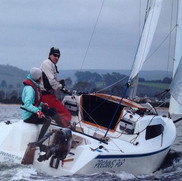
Photo galleries are provided on each design page where available

How To Sail a Small Catamaran (Complete Guide)
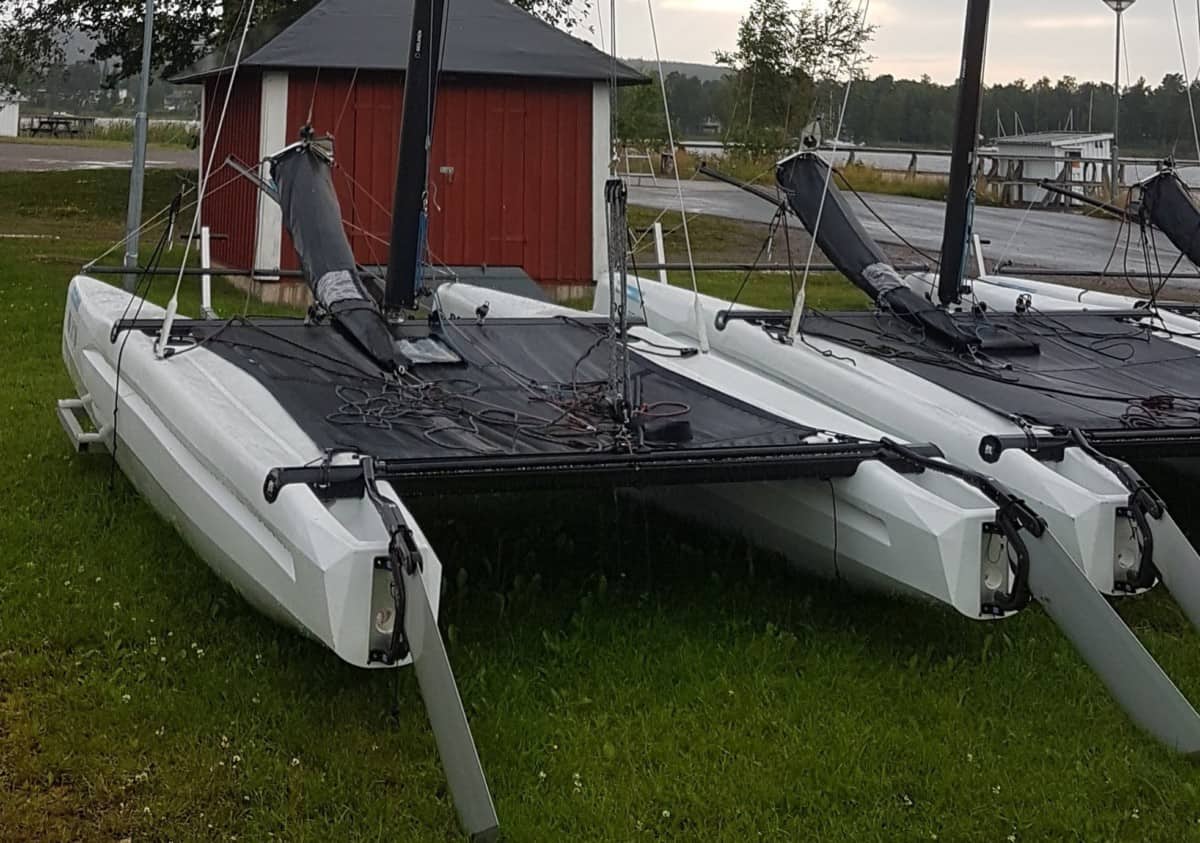
As an Amazon Associate, we earn from qualifying purchases. We may also earn commissions if you purchase products from other retailers after clicking on a link from our site.
Learning how to sail a small catamaran(also known as beach cats) can be the beginning of a new and exciting chapter in your life. It gives you the freedom to comfortably explore the waters, which offers a stimulating and relaxing sensation. If you’re interested in learning how to sail, it is advisable to start with a small catamaran.
To sail a small catamaran (beach cat), first, familiarize yourself with the catamaran’s essential parts and common sailing terminologies. Understand how it works and equip yourself with the necessary sailing gear. Additionally, you’ll need to understand the points of sail, how to steer, turn, and stop the cat.
This guide outlines what you need to know about sailing a small catamaran. Read on to learn more on:
- What is a catamaran?
- Understanding how a catamaran works
- Getting equipped
- Sailing basics
Looking to buy a small catamaran? Read my article Best Catamarans For Beginners
Table of Contents
Understanding a Catamaran
The first step in learning how to sail a small catamaran is to understand its essentials. We begin by looking at what a catamaran is, its essential features, and some standard sailing terms. Understanding the necessary parts of a cat and sailing terminologies helps with communication when sailing.
What Is a Catamaran?
A catamaran is a famous multi-hulled water vessel that features two parallel hulls and sails. Catamarans vary in size and shape, depending on the model and design. However, here we’re looking at the small catamarans (a.k.a. beach catamarans) and how to sail them.
Parts of a Small Catamaran
Below are the essential parts of a catamaran regardless of its model or design:
- Hull : It is the main body of the cat. It has a symmetrical shape, which reduces the drag caused by water friction.
- Tiller : It is a handle or bar that turns the catamaran’s rudder.
- Rudder : An underwater vertical moving board often turned using a tiller (or steering wheel) to initiate movement.
- Keel : It is a centreline attached below the hull running from the front (bow) to your cat’s back (stern). The keel offers stability to the cat and reduces the chances of it capsizing.
- Mast : A long pole set upright from the center of the boat to support the sails.
- Mainsail : It is the most critical sail on a cat that is attached to the mast.
- Foresail : Also known as the jib. It is a sail that fits into the foretriangle of the mast.
- Boom: This is a horizontal pole attached to the mast used for extending the foot of the mainsail.
A full interactive guide on catamaran parts explained ?

Common Sailing Terminologies
Now let’s look at some terms to add to your sailing vocabulary.
- Point of sail : The direction of your cat relative to the wind.
- Port : When facing forward, your cat’s left side is referred to as the port.
- Starboard : Refers to anything to the right of your cat when you are facing forward.
- Bow/ stern : The front and back of the catamaran, respectively. Additionally, you can refer to the bow as ‘forward’ and the stern as ‘abaft/ aft.’
- Tack: Changing the direction of your cat by turning the bow through the wind.
- Jib (gybe): Turning the stern of your cat through the wind to change direction.
- Heeling: A situation where the wind pushes your cat as it leans over in the water.
- Windward: The side of your catamaran that is closest to the wind. It can also be defined as the direction upwind from the point of reference.
- Leeward: The side of your cat far away from the wind. It is the direction of a cat upwind from the point of reference.
- Aboard: On or within the catamaran
- Halyards : Ropes used in raising or lowering the sails on the mast.
- Sheets: Are ropes that control the angle of the sails relative to the wind’s direction.
- Tacking vs Jibing Explained
Learning How a Small Catamaran Works
After gaining knowledge of parts of a cat and the common sailing terms, the next step is to understand how the catamaran works. Here, we’ll look at how the wind gets your catamaran moving.
As the sail of your small catamaran fills with wind, it forms an airfoil that propels your cat. Your sails play the most significant role in keeping your cat moving. As a result, you have to pay much attention to their positioning relative to the wind.
You start by raising the sails using the halyards. The mainsail (the sail closest to the stern) should be raised first, followed by the jib (the sail closer to the bow). With your sails raised, you should then trim them relative to the direction of the wind. By trimming your sails, you position them at an angle where they capture more wind.
As a newbie, you should first learn raising and trimming the mainsail before the jib because you will use it more when sailing your small catamaran.
However, you should note that you don’t rely solely on the sails and the wind to get your catamaran moving. You should also use the tiller to move and control the rudder. This way, you will be in a position to angle your cat in your preferred direction.
As you continue sailing, the wind’s direction keeps on changing. As a result, you should use sheets to trim your sails while tacking and jibing with respect to the wind’s direction changes.
Getting Equipped
After learning how a catamaran works, you are a step closer to practicing in the waters. However, before this, you need to prepare yourself by getting the right sailing gear. Your instructor should advise you on the right clothes and safety equipment.
Here are some items you should not leave behind:
- Shoes : You’ll need a pair of fitting shoes that you can comfortably use on the deck. They should be grippy and non-marking.
- Gloves : It is also advisable to have quality sailing gloves. They should be comfortable to wear and also allow you to control the tiller and perform other duties on board. Consider getting heavy-duty and breathable gloves.
- Sunglasses: You’ll also need good polarized sunglasses that will protect your eyes from the glare. When learning how to sail, it is essential to see how the water is moving. This helps in learning how to read the wind.
- Windbreaker : Do not forget a piece of clothing that will keep you comfortable even under windy conditions. It should be warm and waterproof.
- Logbook: You’ll also need a book where you can keep all your sailing records. You can indicate how many sailing classes you’ve taken, the number of hours you’ve sailed, and the waters, shallow or deep.
- Compass / GPS : Don’t leave behind a compass and a map. These come in handy when you want to find a bearing or are lost in the sea.
- First aid kit : When packing your essentials, don’t leave behind a first aid kit. As a newbie, you might have sea sickness during your first sailing sessions. Carry a kit with the right prescriptions.
- Finally, do not leave behind a phone and a power bank, plus enough food and water.
After preparing yourself for sailing, you should also prepare your small catamaran.
Preparing the Catamaran
Preparing your beach catamaran for sailing involves analyzing its parts and studying the prevailing weather conditions.

Perform a Physical Check
First up, conduct a detailed physical check to see if all the parts are in their stable working conditions:
- Check if the tiller is moving freely to control the rudder.
- Look at the condition of your sails. Ensure they are straight and with no holes or frayed edges.
- The rigging should be in their perfect working conditions. Check the standing rigging (everything that keeps the mast and sails upright) and the running rigging (the lines used to raise and control the sails).
- Check all lines . They should be free. This means they should not be wrapped against each other or around any objects aboard. Here you may also need to tie line knots if you intend to use them during your sail.
Study the Wind
Before getting into the waters, you’ve to study the direction of the wind. Knowing how the wind is blowing helps in the proper positioning of the sails and the cat. You can check the wind’s direction by looking at wind instruments in your small catamaran.
Most catamarans have wind indicators strategically placed on their mast. You can use this. Additionally, you can tie small flags on the sides of your cat to help with the direction. Knowing where the wind is coming from allows you to position your cat at the right point of sail.
Points of Sail
The point of sail defines the direction of the wind relative to your cat. With the right point of sail, you will be in a position to sail your catamaran smoothly. The point of sail differs depending on the angle of your cat from the wind. The different points of sail include:
- Running : In a running point of sail, the wind blows behind your back. It is not advisable to use this point of sail as accidents are prone to occur if the wind’s force pushes over your small cat.
- Broad reach : The wind is partially at your back and your side (aft quarter).
- Close reach : Here, you are sailing at approximately 60-75 off the wind.
- Beam reach : You position your cat at an angle of 90 of the wind. It is considered the most precise sailing position.
- Close haul : At this point of sail, you are approximately 45-60 off the wind.
Hoisting the Sails
Now that you have already identified the wind’s direction and positioned your cat, the next important thing is hoisting the sails. While hoisting your sails, it is advisable to start with the mainsail.
- To start with, secure the bottom front of the mainsail to the respective shackles on the boom.
- Notice a small line known as an outhaul that attaches the clew (the lower back part of the mainsail) to the boom. Carefully pull it out until the mainsail forms a smooth airfoil allowing wind to blow over it.
- Now pull down the halyard until it stops . You will notice some flapping on the mainsail, which is normal.
- Ensure that the mainsail’s edges are smooth , then attach the halyard on the winch or cleat.
- Now shift to the jib and hoist it . Start by securing its bottom front part to the boom and then follow a process similar to that of hoisting the mainsail.
Start Sailing
As a newbie, you need to ensure you are on a safe sailing point during your practice sessions. Avoid going far into the waters with your small catamaran during your first training sessions.
Also, ensure that you have enough space around you for your catamaran to turn in response to the wind movements. This is to avoid being thrown back into the dock or in the sand by the moving wind.
As you start sailing, you’ll notice the effects of the wind on your cat. As a result, you may need to make a turn through tacking or jibing .
When sailing, always make sure you place yourself at the right point in your catamaran. Sit at the side where the wind is blowing to; the wind should blow from your back. This means you should be on the opposite side of the sail and not beneath it. Sitting on the wrong side might cause your cat to flip over.
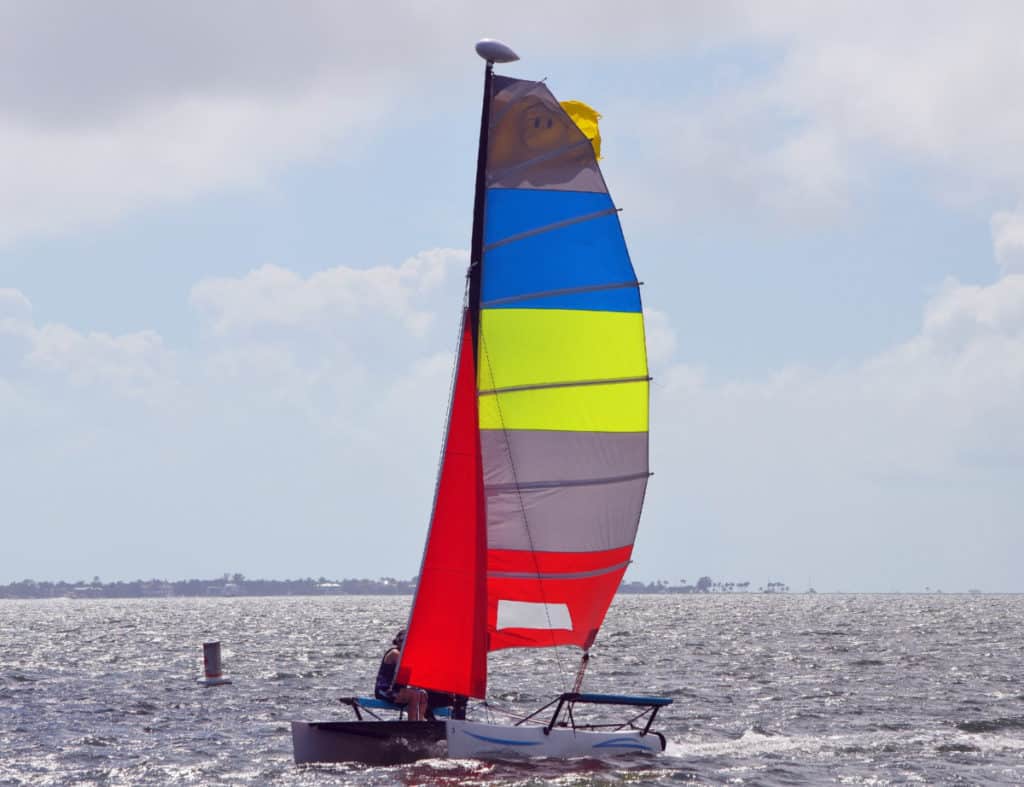
Now that you already know how to get your cat moving, let’s look at steering. Steering the cat is often unclear to most newbies.
Small catamarans are steered using a tiller that controls the rudder. What confuses most sailors is that you move the tiller in the opposite direction from which you want your cat to move. So, if you’re going to turn to the right, you will push your tiller to the left and vice versa.
Since steering a small cat differs from steering other moving vessels, the experience may feel awkward at first. However, you shouldn’t feel pressured to master it all at once. Take your time and practice until you master the process.
Trimming the Sails
As you continue learning how to sail, you also need to understand how to control your cat by trimming sails. Trimming sails means adjusting the positioning of your sails to control the movement of your cat.
As a learner, to effectively and safely trim your sails, you should first position your tiller to reduce the movement of your cat to either side. Start by trimming the mainsail.
Tighten the mainsail to stop flapping and for it to take a new shape relative to the wind’s direction. As your mainsail takes a new form, your cat will start building some speed. Quickly grab the jib and adjust it too.
To tighten the jib, stretch it as much as you can to reduce flapping/ luffing. Once the flapping has reduced, loosen it and let it out until the edge of its luff (the forward end of the jib) is shaking. Now tighten it back in its new position, and you are ready to go.
If you are sailing close to the wind, you have to keep your sails tighter than usual. On the other hand, if you are sailing off the wind, your sail should be left loose. Generally, tight sails cause your cat to move faster, while the opposite is true for loose sails.
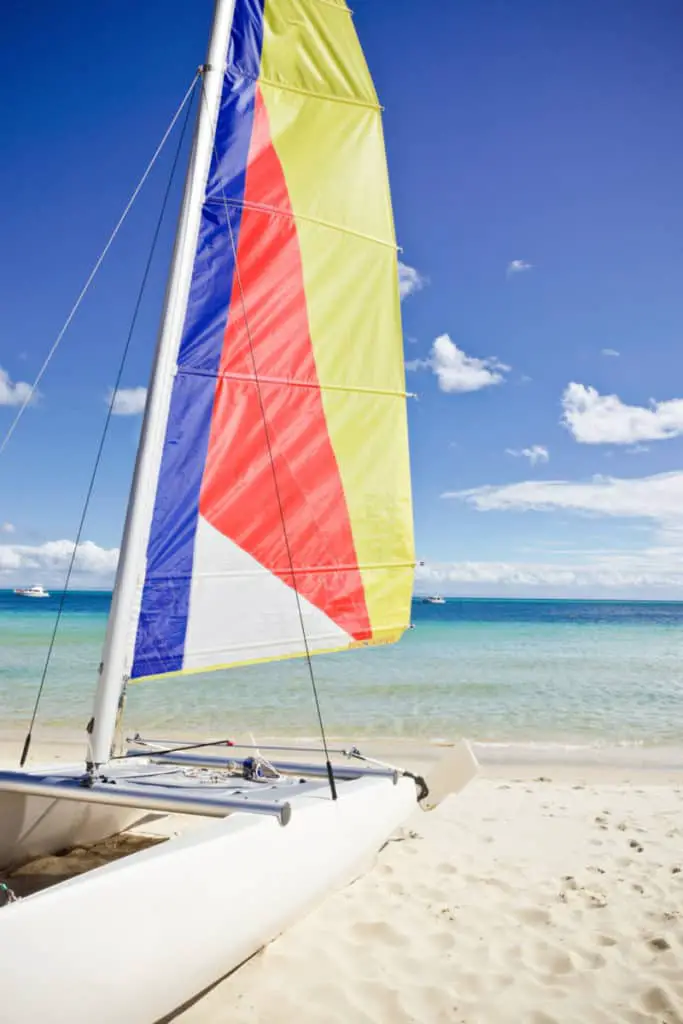
Turning the Catamaran
You’ll also need to learn how to turn a catamaran. As a learner, after releasing the mooring line, you should be prepared to turn the catamaran by moving the boom to either side. As you push out the boom, the wind will hit your sail from the back, making your cat turn.
Therefore, you should be cautious enough to avoid turning in the wrong direction. Like in moving the tiller, you also push out the boom into the opposite direction you want to turn. Therefore, when turning to the right, you push out the boom to the left and vice versa.
Slowing Down and Stopping
Although sailing a small catamaran at high speeds is fun, you may at some point want to slow down. When you detect an obstacle in the water, you may need to slow down. Most sailors use the term ‘spill wind’ to refer to the action of slowing down and stopping a cat.
Since tighter sails often accelerate the speed of your cat, you can slow it down by loosening them a little. The more you let your sails out, the more your cat slows down and eventually stops.
It is advisable to release the sails as you face the wind’s direction to help your cat stop. If you are sailing against the wind, first turn your cat in the direction of the wind, then release the sails.
Practice slowing down and stopping your cat under different weather conditions to be prepared in case of an emergency. Since your cat has no brakes, you should practice this until you perfect your skills.
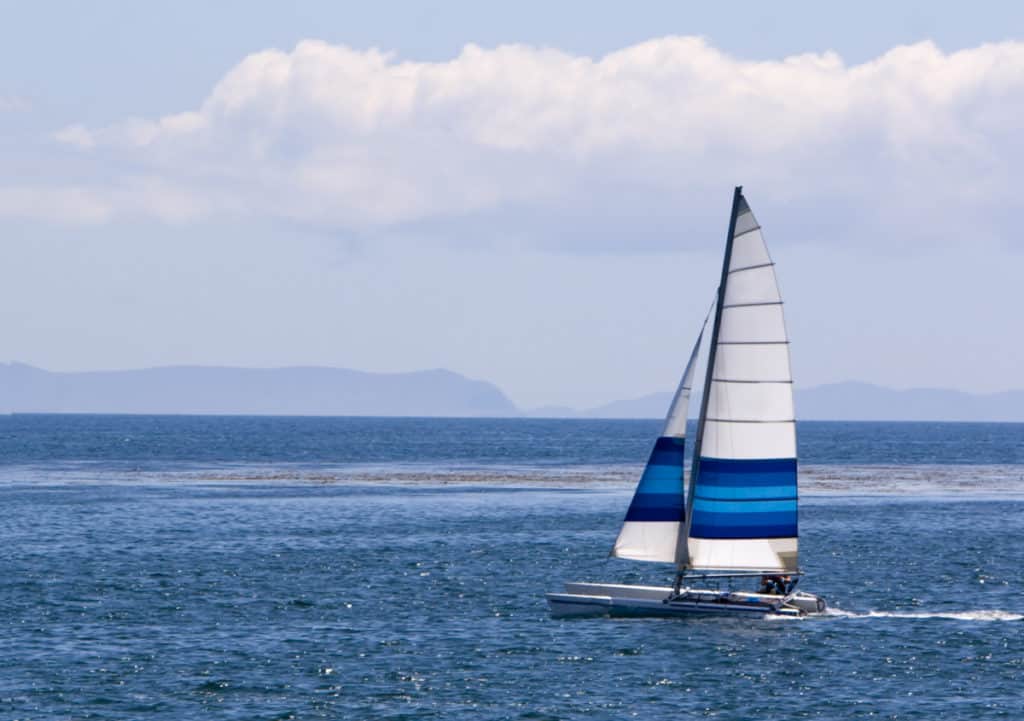
Capsize Recovery
Although capsizing is not common in catamarans, it can happen and it is crucial always to be prepared. If your small catamaran capsizes, it is advisable to start the recovery process immediately before the situation worsens. Let’s look at how to right a capsized catamaran.
Why and how often do catamarans capsize, a scientific approach!
You can right most small catamarans by pushing the bow or stern below the water to rotate them upright.
To right your capsized catamaran:
- Lower down your bow and stern until your cat lies in a vertical position.
- One crew member should then swim around to one end of the lower hull and then push it down. By pushing the lower end down, the uppermost hull’s end comes down towards the water.
- As the uppermost hull drops towards the water, it is pulled down by another crew member. In the meantime, the other crew pushes the cat up midway along the lower hull.
- This movement puts your cat in a vertical position in the water. The crew members then swim to the mast and push it back to its standard sailing position. They then climb aboard fast before the cat sails off.
Avoid sailing alone. Always have some crew members to help you out in case of a capsize.
Learning how to sail a small catamaran is a process that requires practice and patience to perfect your skills. Therefore, don’t feel pressured; take it slow, a step at a time. Start by understanding the essentials of a catamaran, preparing yourself and your cat for the adventure, and learning some sailing basics.
The fundamental sailing basics outlined in this guide are the points of sail, steering, trimming sails, slowing down, and righting a cat after a capsize. Follow our guide today and become a pro in sailing a small catamaran.
- Catamaran Parts Explained
- Why do catamarans capsize?
Owner of CatamaranFreedom.com. A minimalist that has lived in a caravan in Sweden, 35ft Monohull in the Bahamas, and right now in his self-built Van. He just started the next adventure, to circumnavigate the world on a Catamaran!
Leave a Reply Cancel reply
Your email address will not be published. Required fields are marked *
Save my name and email in this browser for the next time I comment.
Recent Posts
Must-Have Boat Gear for Catamaran Sailors!
Sailing is probably the most gear-intensive activity I've ever done; there are so many decisions to be made about what gear to buy now, for tomorrow, and what to definitely never buy. The gear on...
6 Best Trailerable Trimarans For Bluewater and Coastal Sailing
Having a boat costs a lot of money, even when you are not using it, marina fees, etc. And once it is in the water most sailors never go very far from their "home marina" and sailing will be somewhat...

James Wharram Designs
Search Our Site
Mana 24 - self-assembly 'cat-kit', wharram's first kit boat.
Introducing the CNC-cut self-build 'Cat Kit', a trailable family camping boat. All plywood parts are pre-cut - just take it out of the box and assemble it yourself! Keep it at home, trail it and sail it anywhere. MANA is the Polynesian word for 'spirit' given to an object by its maker or the person that uses it.
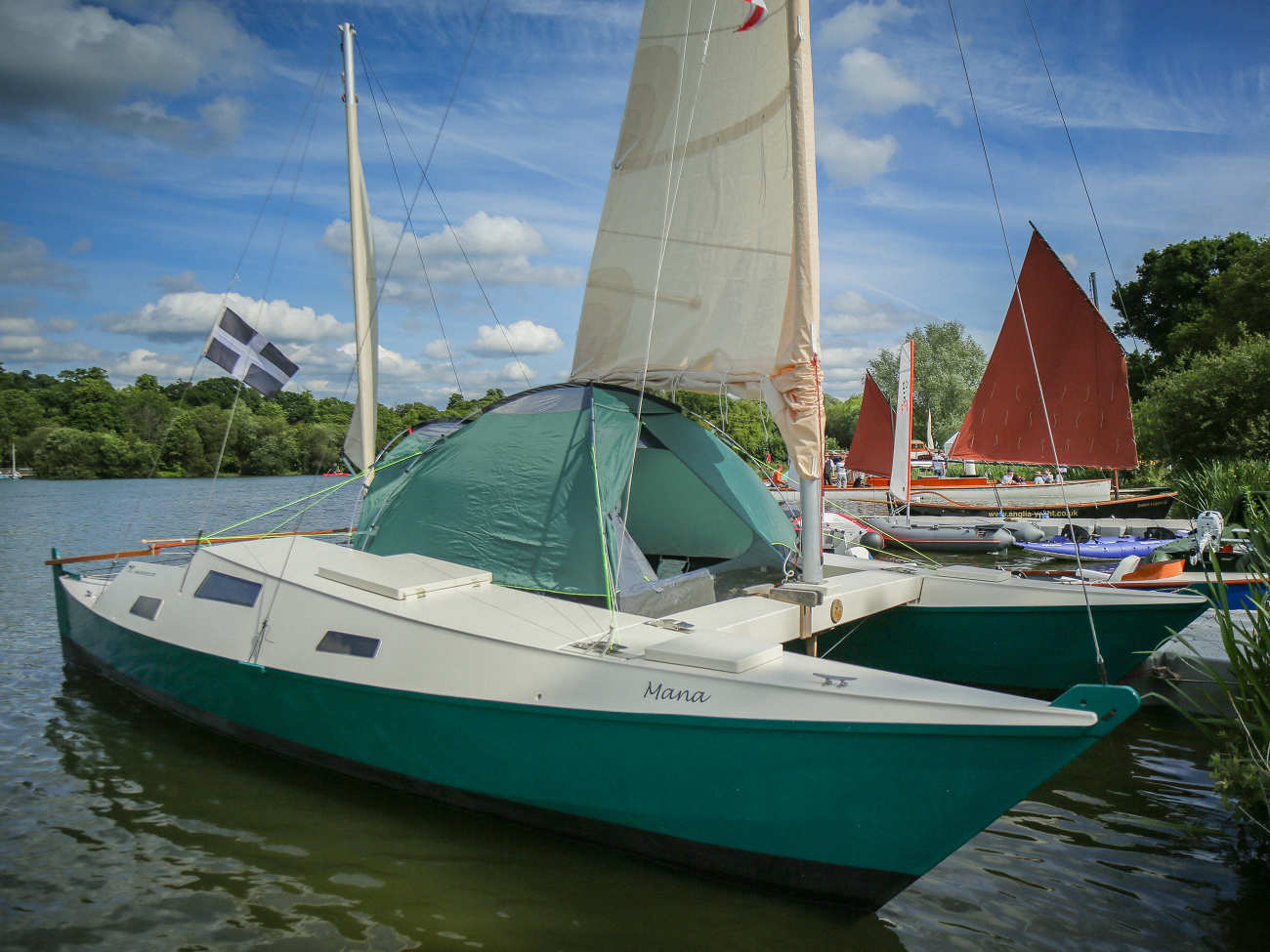
An Economical Way To Enjoy Sailing
Due to the present period of financial austerity and increasingly high marina costs, a large number of would-be sailors are having a hard time financing the dream of sailing their own boat.
However, there is an economical way to enjoy sailing, by building your own small lightweight boat, keeping it at home and trailing it to the waters you want to sail in , chasing the good weather. This gives the opportunity to explore many more sailing areas than if based on a permanent mooring and at a much lower cost.
In designing the MANA, we explored this idea and looked sideways into the world of camping and have combined the innovative CNC cut "flat pack" boat-building concept with the philosophy of outdoor living to create the unique MANA camper-sailer, specifically designed for trailer sailing.
All these ideas have come together, resulting in the new MANA 24 design, a catamaran specifically designed for trailer sailing. The MANA kit is sold with all the plywood cut out by CNC cutter , so building the boat at home will be a bit like assembling a flat-pack . All the parts slot together perfectly so a hull can take shape in a day.

Building from such a kit takes away the worry of measuring and cutting all the boat parts, which can be quite daunting to many first time builders and saves a lot of time in the early stages of building. As she is built from a pre-cut kit, we have been able to give the Mana more complex and beautiful shaping , giving her more interior volume than the Tiki designs. During construction all the kit parts slot together and are locked with wooden wedges, so no room for error. Even all the stitch holes (for fastening joints with cable ties) are drilled and lines scribed where to glue on bearers and stringers.
MANA's 23'6" hull length has a special significance for James Wharram . In 1956 he made the first successful catamaran voyage across the Atlantic in his first catamaran, the 'Tangaroa', also 23'6" long.
In trailer/sailer design every increase in length equals harder launching and recovery work. At 23'6"- 7.15m hull length MANA 24 sits between our TIKI 21 and TIKI 26 designs (both very popular trailer sailers), with easier launching and handling like the smaller TIKI 21, but an interior space close to that of the Tiki 26 . Her new chined hullshape gives more width for the bunks, which are placed aft where the hulls are widest, and where there is least motion.
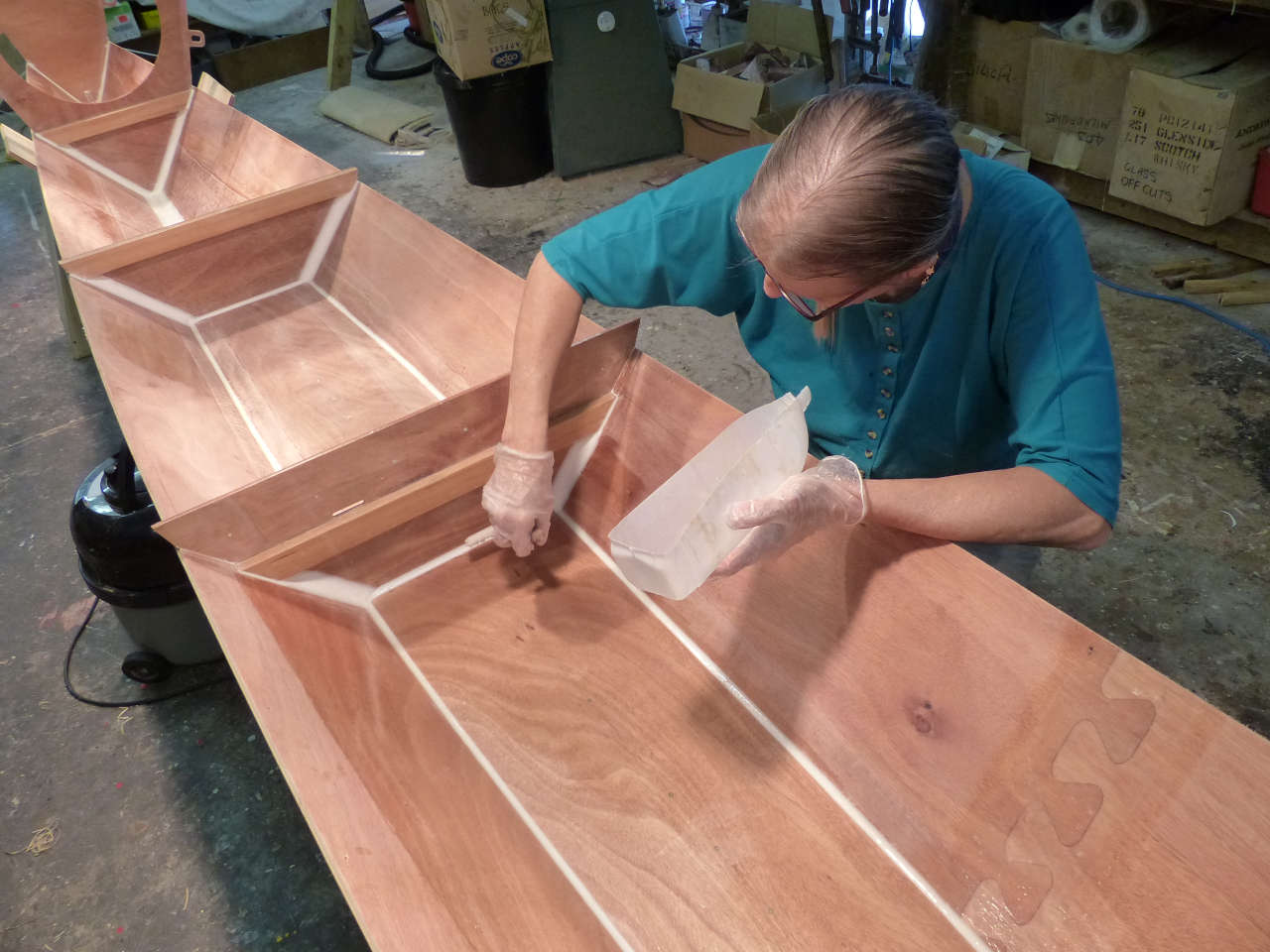
For speedy assembly the hulls and beams of the MANA are connected with quick-fit webbing straps with over-centre buckles, which are very strong and much easier to fit than bolts.
With the main mast of the MANA placed well forward the platform gives ample flat space for a low cost dome tent or a custom-made pramhood tent, which can double as spray hood when sailing. Adapting camping habits to a sailing lifestyle gives wider sailing opportunities at minimum cost and lots more family fun!
MANA uses the well proven Wharram Wingsail rig in a new Catrig configuration. The Wingsail rig is a modern version of a high aspect Dutch style gaff rig, sleeved round the mast for maximum aerodynamic efficiency.
In this new Catrig configuration the mainsail gives the drive with a very clean leading edge. The small mizzen aids with balance, steering and tacking . Having no jib, there is no need for a very tight forestay. The standing rigging uses the latest dyneema rope, which is light and easily set up. The mizzenmast can be used as sheer pole for single-handed assembly.

Mana 24 Design Data
| Building Method: | Ply/Glass/Epoxy/Laminate | |
|---|---|---|
| Length Overall: | 23' 6" | 7.16 m |
| Beam Overall: | 12' 8" | 3.85 m |
| Waterline length: | 20' 10" | 6.35 m |
| Beam of each hull: | 3' 2" | 0.97 m |
| Max draft: | 18.5" | 0.47m |
| Headroom over seat/bunk: | 3' | 0.90 m |
| Sleeping capacity: | 2 single bunks in hulls, double birth under decktent | |
| Dry weight (approx): | 1190 lbs | 540 kg |
| Maximum displacement (Approx): | 2510 lbs | 1140 kg |
| Sail area: | 216 sqft | 19.6 sqm |
| Deck sleeping area: | 7'3" x 8' | 2.20m x 2.45m |
| Full deck area: | 7'3" x 11'6" | 2.20m x 3.50m |
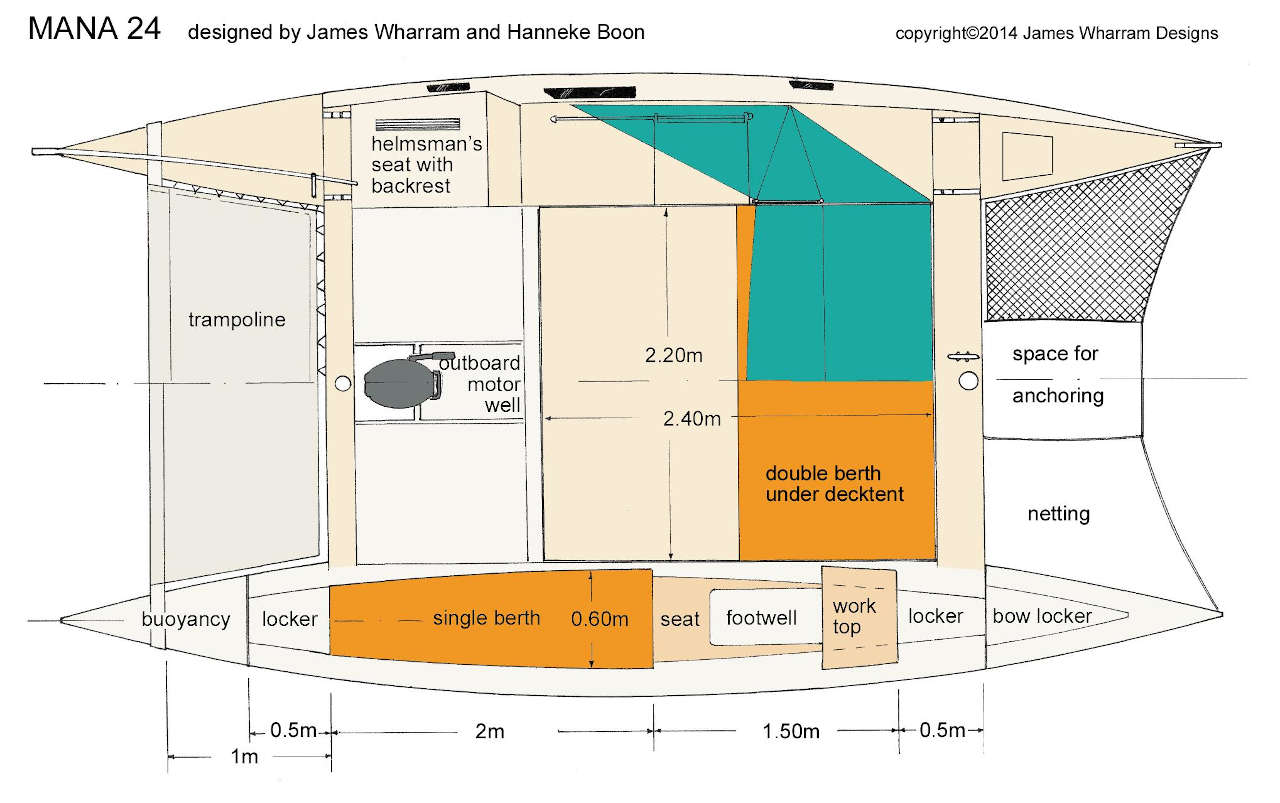
What You Get In A Mana Kit
CNC cut plywood parts, timber parts, epoxy materials, fastenings, ropes, blocks and fittings are all included in the kit. See the price list .
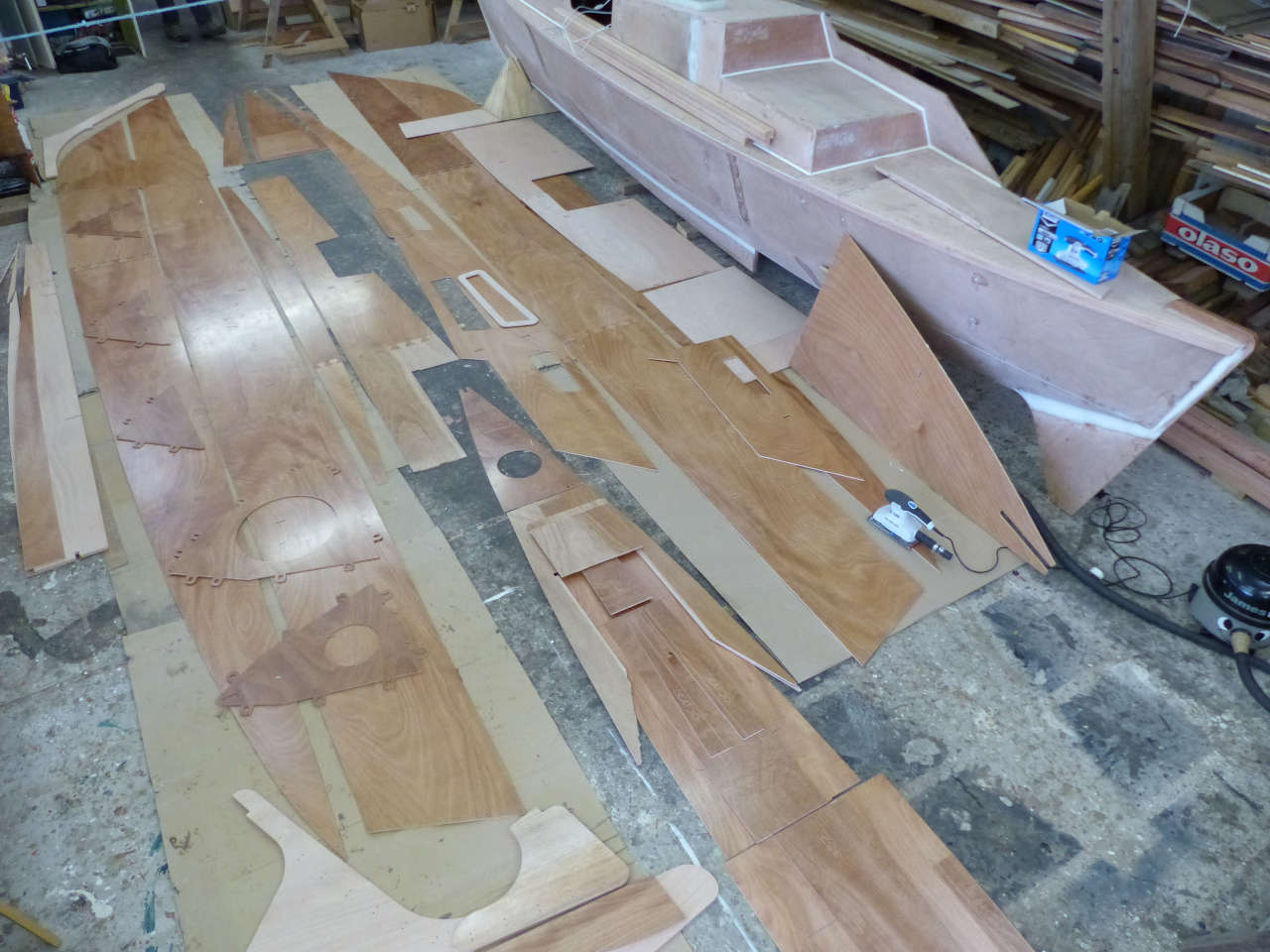
Transporting The Mana Kit
The entire kit can fit and be transported in the back of a van with ease. The van in the photos is a VW Transporter.

Boat In A Box
Your Mana 24 kit will arrive in a box like this!
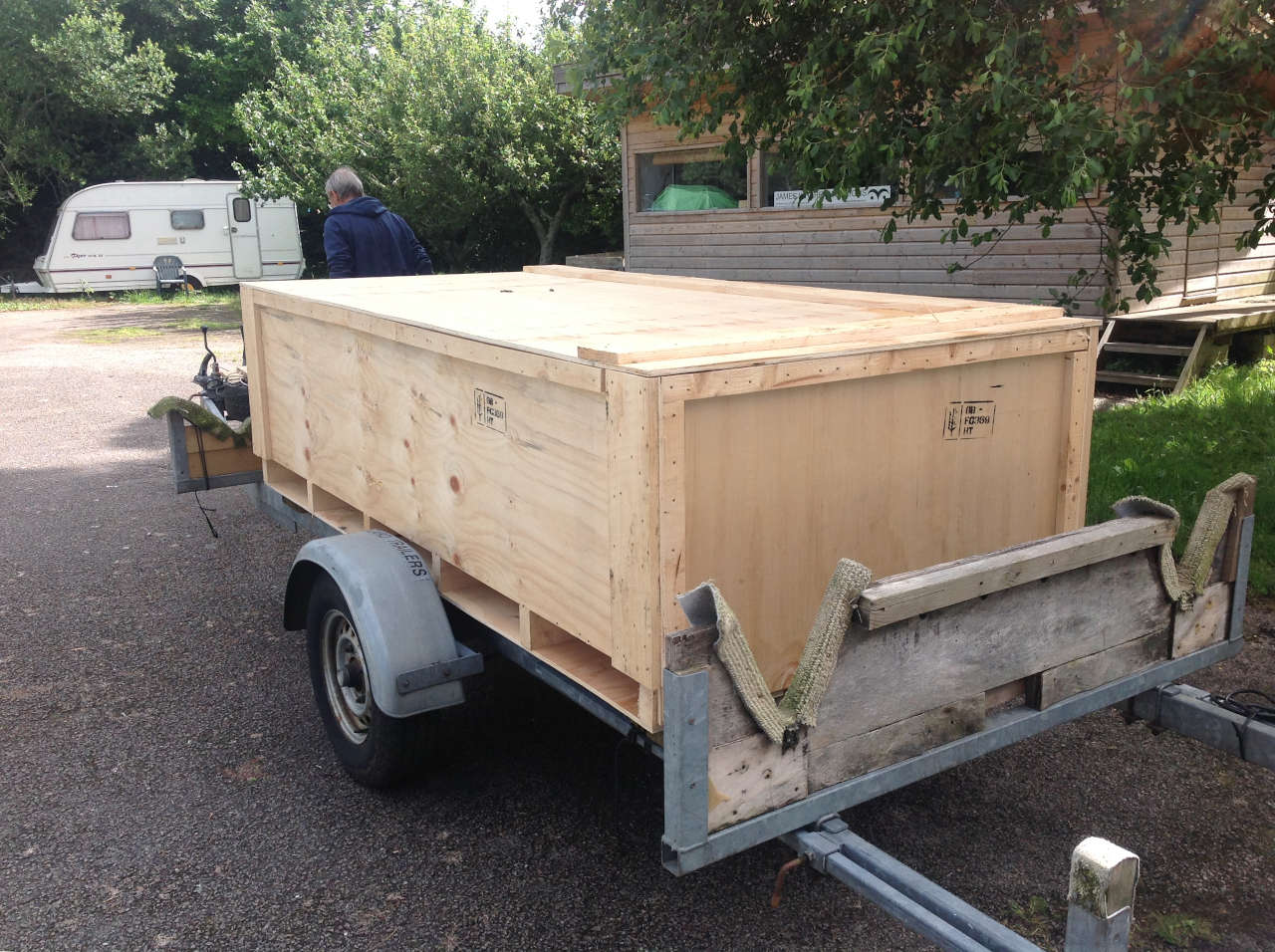
We're Taking Orders
The Mana 24 kit is now available and we are taking orders. We will be handling each order individually due to different options and shipping costs, so if you would like to discuss ordering a Mana kit, please contact us , we will then be able to work out shipping details to your building site and supply you with a pro forma invoice.
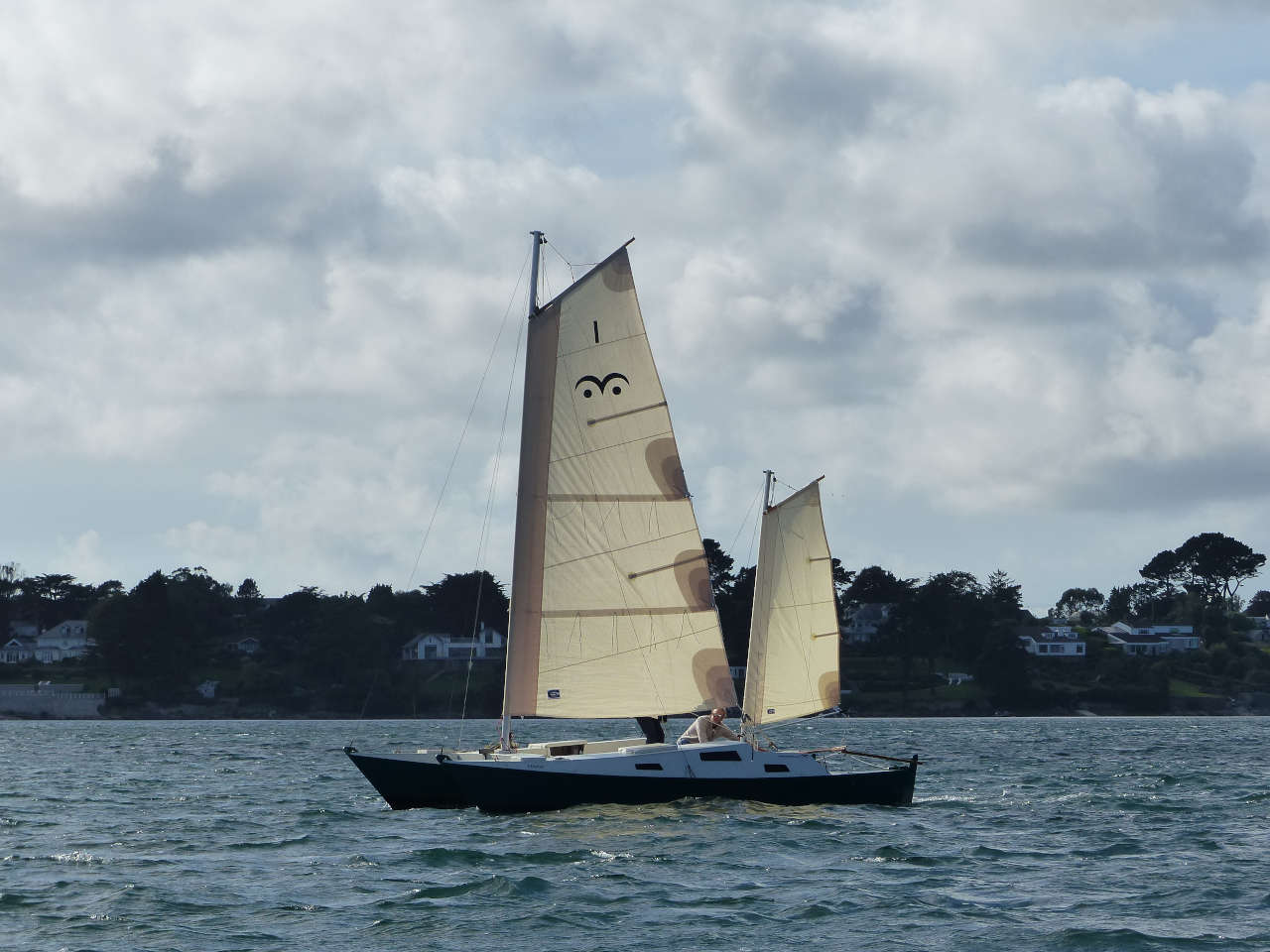
Cost of complete kit, including all fittings, masts and sails is £12,750 (if bought complete, separate costs below). All prices excluding VAT, and excluding shipping costs (shipped FOD, Freight on Delivery).
If your budget is tight, it is possible to buy the kit in two stages , buying masts, sails, rigging, ropes and fittings later. Or you can buy just the basic Boatbuilding Kit which includes the building rights and plans, and source fittings, rope and fasteners yourself as all are detailed in the plans.
1. Boatbuilding Kit - Total Cost £9,975
- Complete set of plywood parts to build two hulls, crossbeams and motorbox, CNC precision cut. All plywood Robbins Elite BS1088 Marine Plywood, guaranteed for 15 years, manufactured from selected Gaboon (Okoume) veneers throughout
- Platform panels, 2 large, 2 small, prefabricated from 40mm plastic honeycomb, glassed top and bottom
- Small hardwood timber parts, CNC cut to size, ready for final shaping, sanding and fitting
- Perspex windows and washboards, CNC precision cut
- WEST Epoxy kit, includes all resins * , pumps, fillers and glass cloth, mixing sticks, 1 box vinyl gloves, 1 rubber squeegee
- Sikaflex 295 for fitting windows
- Sikaflex 221 for bedding fittings etc
- Neoprene rubber for sealing hatches
- Rubber for padding beam mounts
- Gripfast nails, stainless steel machine screws, cable-ties and roller-sleeves (to be cut into paint/epoxy-pads), 2 paint-pad handles.
- Douglas Fir timber for stringers, framing etc and hardwood for hatch coamings (mahogany) and keel strips (iroko), all in long lengths to be cut to size by builder *
* N.B. For overseas customers Boatbuilding Kit should be bought excluding the long lengths of Douglas Fir and hardwood timber for easier transport. Cost deducted by £1100. We can also not include the epoxy resin and hardener as these are hazardous products with freight restrictions. You will need to buy these through your local dealer. Cost for these deducted by £900. (i.e. Cost of Boatbuilding kit excl. long timber and epoxy £7,975).
2. Blocks, Fittings And Rope Kit - Total Cost £1,200
- All blocks, cleats, shackles and other fittings to rig the Mana
- All ropes for sheets, halyards, lanyards and standing rigging (Dyneema)
- Stainless steel buckles and webbing straps for crossbeams
- Shockcord for tillers and hatches
- Aluminium boathook/mizzen boom
- Set of fittings for both mastheads and hinging unit for base of main mast, fabricated from aluminium and stainless steel
3. Sails, Made By Jeckells Of Wroxham - Total Cost £1,530 (Specify Colour)
- Mainsail with two reefs
- Mizzen with 1 reef
4. Masts * - Total Cost £510
- Aluminium mast tubes. 4 ½” OD x 10swg for main mast, 2 pieces @ 5m and 2.30 long, plus sleeve. 3” OD x 10swg for mizzen, 4m long.
* N.B. For overseas customers we suggest you source your mast tubes locally as shipping long lengths will be costly.

Building Time Estimate
We kept precise building hours while building the prototype. We built to a high quality standard with excellent finish, i.e. a lot of time spent on precision sanding, fairing etc. Building time in the early stages of building is greatly reduced by the CNC cut plywood parts, which takes away all the worry of measuring and cutting and lets the builder assemble the hulls very quickly.
Summing Up Of The Times We Took
- All construction work; hulls, beams, gaffs, tillers, hatches, including epoxy coating all interior surfaces: approx. 500 hours
- All exterior glassing work; hulls and crossbeams: 90 hours
- All sanding of glassed surfaces: 45 hours
- Painting, two coats epoxy primer, two coats 2-pack topcoat incl. non-slip decks and antifouling: approx. 80 hours
N.B. What should be noted is how many hours it takes to do sanding and painting compared to the building time. Glassing, sanding, fairing and painting add up to 30% of the total building time. On our basic building time estimates in our Design Book, final finishing and painting are not taken into account. Working from a kit does save many hours.
Transport Sizes And Weights
- The plywood kit, including made-up platform panels will be in labeled bagged bundles measuring in total approx. 2.5m x 1.20m x 0.3m and weighs around 300kg
- Fastenings, blocks, fittings and ropes, 1 box, approx. 60 x 40 x 30cm . Weight 25kg
- The WEST epoxy kit measures approx. 1.3m x 0.6m x 0.45m and weighs around 100kg
For overseas transport the above items have to be packaged in one special wooden pallet crate - 2.62m x 1.29m x 0.77m - at additional cost of £250.
- Timber will be a long parcel (around 3.5m - 4m long) and will weigh around 50-60kg
- Aluminium masts, in max. 5m long sections , weight incl. fittings 40kg
For overseas customers we advise them to source the timber and masts locally.
You will be able to collect the complete kit from Cornwall, UK yourself on a trailer or in a van saving on a lot of shipping costs and paperwork.
Interested in building a Mana? Contact us now:

- No products in the cart.
Catamarans and Trimarans
Catamaran and Trimaran Boat Plans make it a reality to build your own catamaran or trimaran. Multi-hulled sailing vessels are a special class of boat. A very different mind set is required when thinking about sailing a multi hull, let alone getting your head around building one.
There are some unique challenges building a multi-hull sail boat, the extra beam added by each hull for instance can create storage issues while under construction. Hartley boat plans make the build process straight forward for even amateur builders. However with all things considered, building a multi can be an amazing journey.
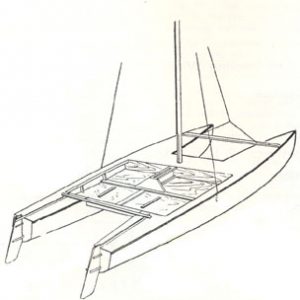
Fast Twin Catermaran
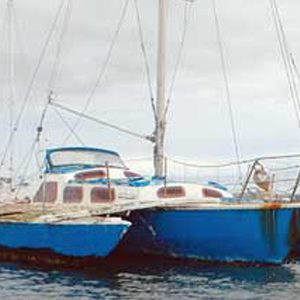
Lively 28 Cruising Trimaran
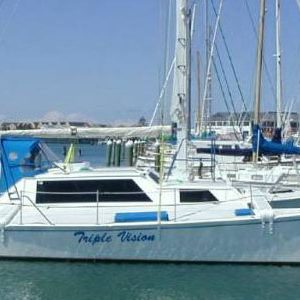
Lively 35 Cruising Trimaran
Portable Boat Plans
- About Designer
- Plan Ordering Information

MINI-CAT
The PortableBoatPlans "2012 Portable Boat Design Contest" is over for another year, and there were two winners (tied votes). The object of the contest was simple: Develop a concept for a small homemade boat that would appeal to many other amateur builders. This year the co-winners both provided a design for a catamaran hull platform boat, with some unique differences. The MINI-CAT by Harold Krause of Texas, featured in this article, is about as basic as you can get, yet it has the potential to be much more. As drawn, it is a little less than 8 feet long and is 4 feet wide. It easily breaks down into four hull modules that are each one foot square by 4 feet long. The deck is composed of 2 sections, each 3 feet by 4 feet wide, and only 2 inches thick. Once assembled, the primary means of propulsion is with oars, or paddles, but a trolling motor is easily adapted to the boat for leisurely cruising, at around 4 MPH.
The second winner is the CAMP CRUISER by James McCabe of Dublin Ireland, a design quite similar in size to the Mini-Cat, also with a twin-hull, but with an enclosed folding cabin for overnight stays on the water. Because of the extra design detail required, the plans for this contest winner will take longer to develop.
It's obvious that the voters of the design contest favored the twin-hull designs. Is this a trend ?
In the meantime, with the plans of the MINI-CAT complete, construction work should get underway this summer. The materials list consists of 2 sheets of 5 MM plywood, and 1 sheet of 1/2 inch plywood, in its basic form. Additional materials, like 1 x 2 lumber and TiteBond 3 waterproof wood glue complete the list. Because of the simplicity of the design, the plans consist of only 26 pages, including the Tape & Glue Process of joint sealing.
The following layout drawing should provide sufficient information about the configuration and overall capability of this small, but stable, platform boat. It can support over 400 pounds easily, and will fit in all Trucks, Vans and SUV's for the trip to and from the water.
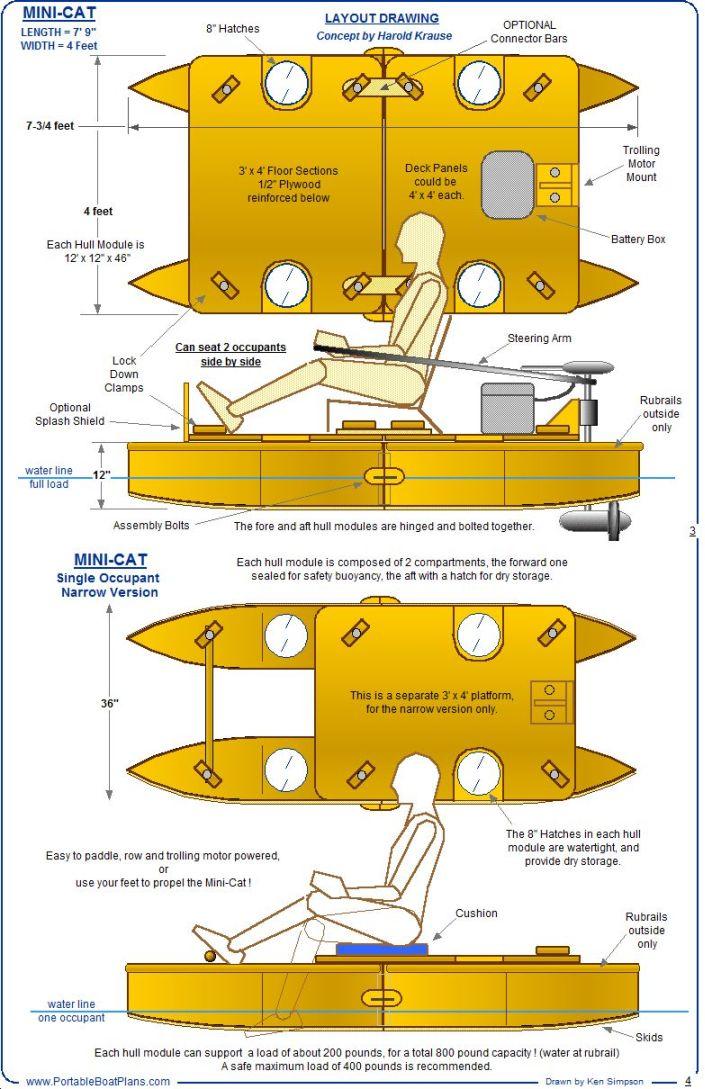
As you can see, there are no complicated shapes to this boat, all easy to cut and assemble panels. The plans do outline in some graphic detail how everything fits together, but leaves open areas for the builder to customize the build to his or her personal taste. Some of the many options might be fishing rod holders, or a fixed enclosure for a cooler. Also, the seating is pretty much up to the builders needs, and can even be a folding lawn chair, or two.
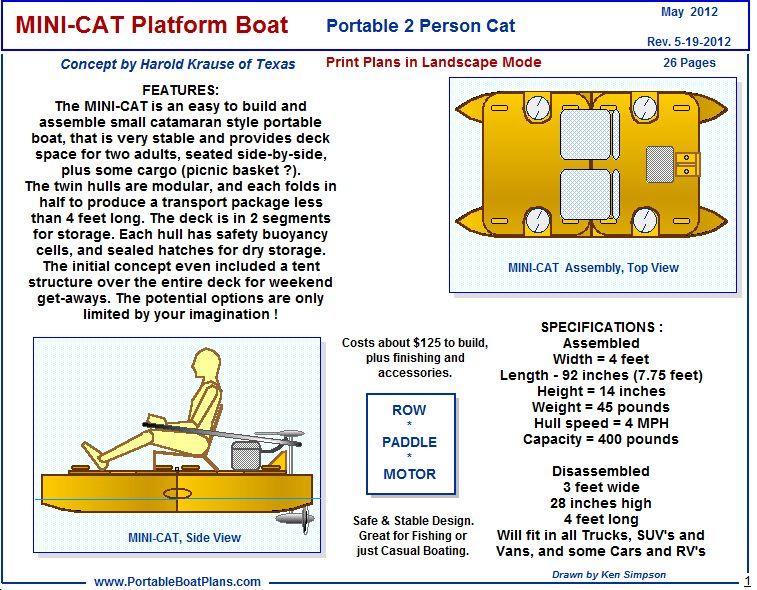
Page 1 of the plans give you a sense of what the MINI-CAT is, and what it can do. Because you sit ON, and not IN the boat, some getting used to will be expected. Perhaps you will want to add a small splash shield to the front of the deck panel, or a small canopy can be easily constructed to provide shade on those sunny days. The options are only as varied as your personal wants and needs.
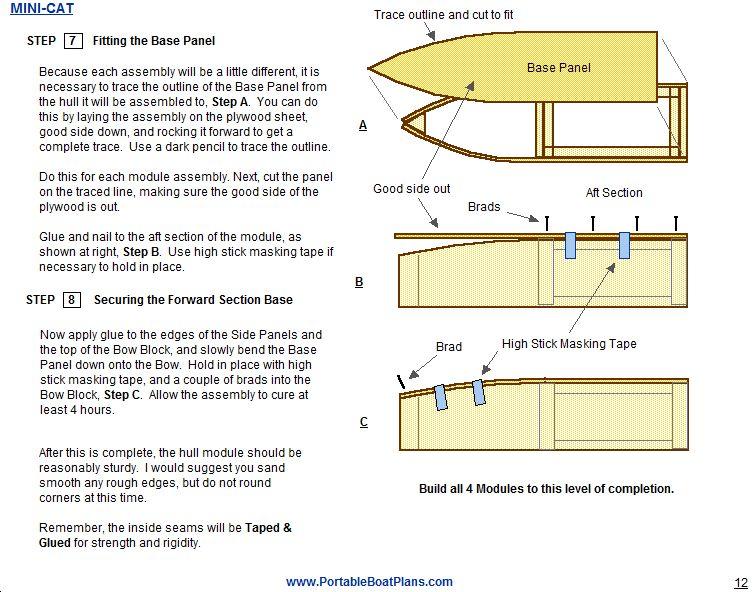
Everything starts at the construction of the 4 hull modules. These are what do the work of holding you steady, and safely, on the water. Although built of thin, light plywood, each module is strengthened by the use of 1 x 2 edge supports, and all seams are Taped & Glued for strength, and to prevent water intrusion into the plywood edges. Instructions are intentionally kept as short as possible, with only detailed descriptions where required. If the builder experiences some misunderstanding of the plans, the designer is only an e-mail away.
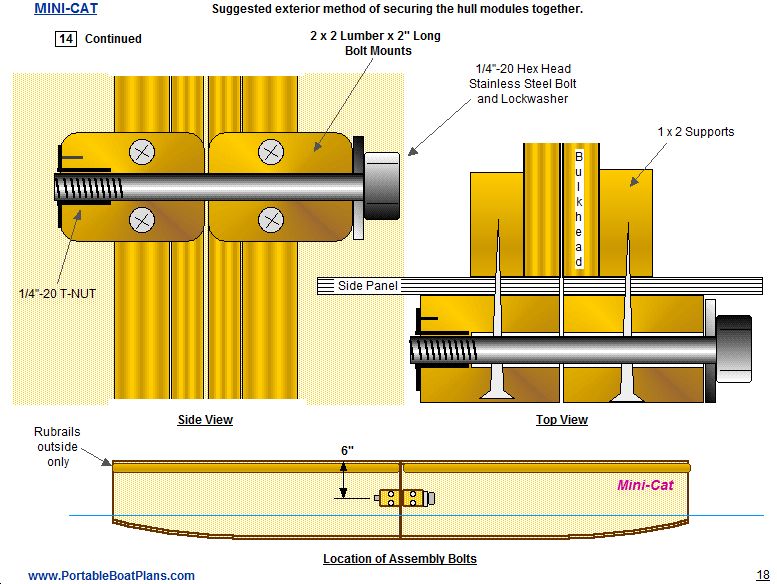
Everyone always wants to know how the whole thing is held together. The above sketch defines the Hull Module Assembly Bolt method of joining the hulls, for a secure yet easy to disassemble process. I have, over the years, tried other methods, but simple Stainless Bolts with fixed T-Nuts has proven to be the easiest to implement.
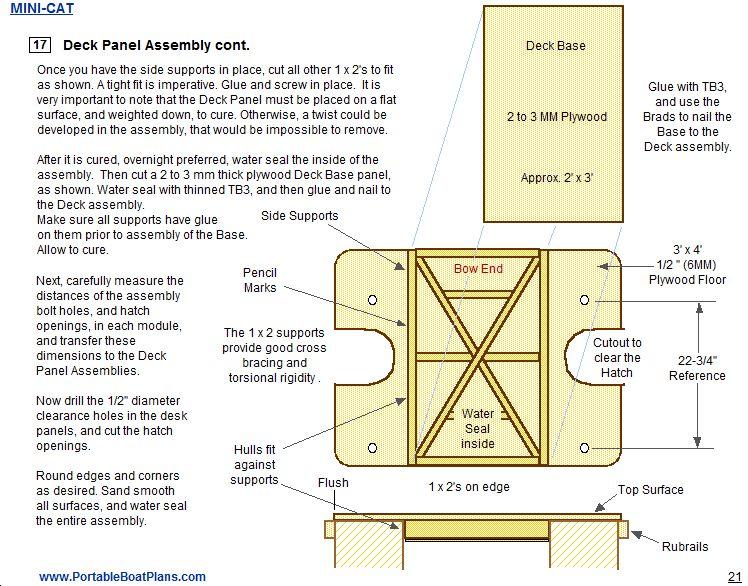
The article would not be complete without some explanation of the Platform assembly. The 1/2 inch plywood panel is simply strengthened by the buildup of a cross-laced system of 1 x 2's on edge, with a thin 2 or 3 MM plywood base cover. The interior is water sealed prior the the placement of the base, so the deck panel also becomes a buoyant platform !
Not big enough ? Simply add a foot or more to each hull module, another deck panel, and make it a family affair.
Obviously, no photos of the finished boat are yet available, but a close study of the plans should give you a sense of what the MINI-CAT is, and what it can be for you. As mentioned earlier, the basic structure of MINI-CAT can become a great starting point for a stable twin-hull, portable, safe, and fun platform boat, one that you have always wanted.
Ken Simpson
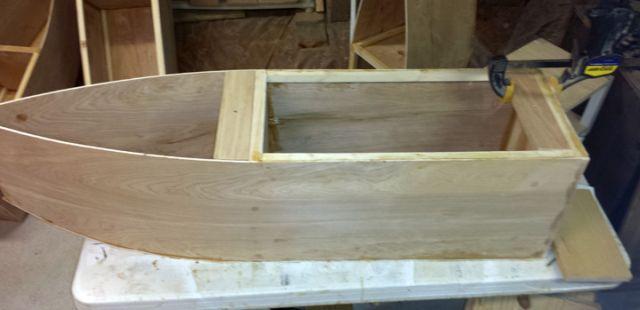
Early pontoon construction, 4 required.
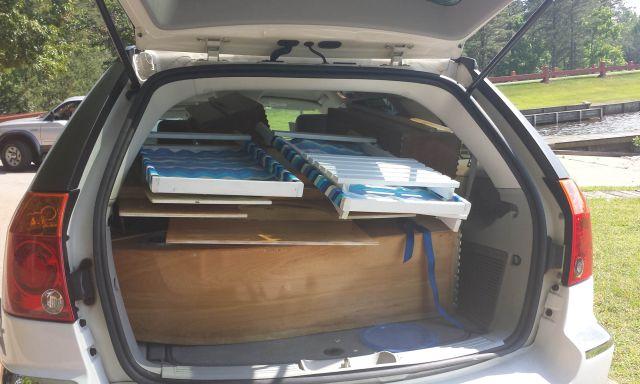
It all fits in the SUV.
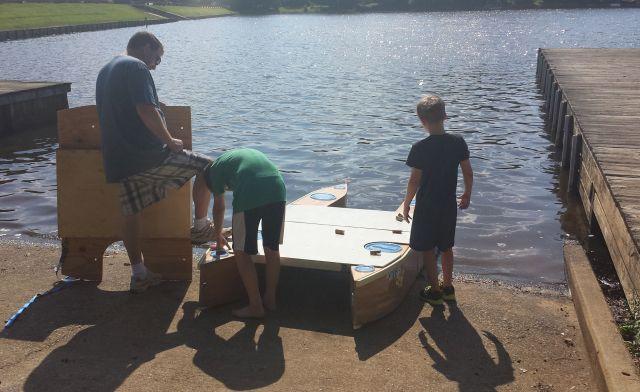
First launch. A family affair.
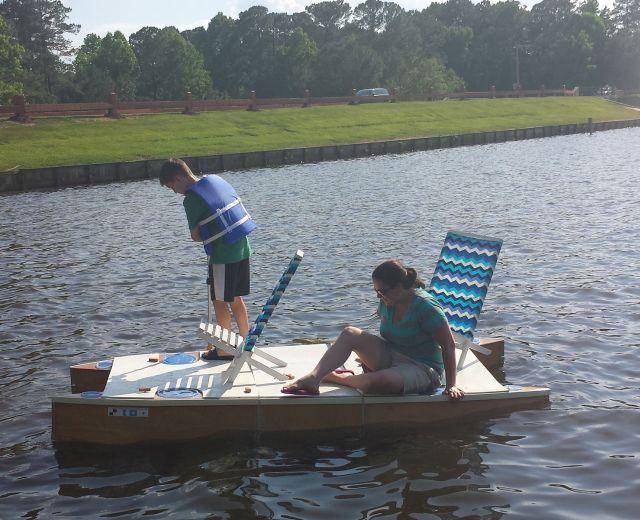
This Mini-Cat was built by Mary Anne Etheridge of North Carolina. As you can see in it's first launch, the deck had a tendency to twist. This condition has been corrected with the addition of cross braces, front and rear, to stabilize the platform. Also note the addition of a center module, necessary for greater capacity. Mary Anne plans to add a safety railing after the sea trials are completed. (June 2014)
RETURN TO HOME PAGE
Make a free website with Yola
- Today's news
- Reviews and deals
- Climate change
- 2024 election
- Newsletters
- Fall allergies
- Health news
- Mental health
- Sexual health
- Family health
- So mini ways
- Unapologetically
- Buying guides
Entertainment
- How to Watch
- My Portfolio
- Latest News
- Stock Market
- Biden Economy
- Stocks: Most Actives
- Stocks: Gainers
- Stocks: Losers
- Trending Tickers
- World Indices
- US Treasury Bonds Rates
- Top Mutual Funds
- Options: Highest Open Interest
- Options: Highest Implied Volatility
- Basic Materials
- Communication Services
- Consumer Cyclical
- Consumer Defensive
- Financial Services
- Industrials
- Real Estate
- Stock Comparison
- Advanced Chart
- Currency Converter
- Credit Cards
- Balance Transfer Cards
- Cash-back Cards
- Rewards Cards
- Travel Cards
- Credit Card Offers
- Best Free Checking
- Student Loans
- Personal Loans
- Car insurance
- Mortgage Refinancing
- Mortgage Calculator
- Morning Brief
- Market Domination
- Market Domination Overtime
- Asking for a Trend
- Opening Bid
- Stocks in Translation
- Lead This Way
- Good Buy or Goodbye?
- Financial Freestyle
- Capitol Gains
- Living Not So Fabulously
- Decoding Retirement
- Fantasy football
- Pro Pick 'Em
- College Pick 'Em
- Fantasy baseball
- Fantasy hockey
- Fantasy basketball
- Download the app
- Daily fantasy
- Scores and schedules
- GameChannel
- World Baseball Classic
- Premier League
- CONCACAF League
- Champions League
- Motorsports
- Horse racing
New on Yahoo
- Privacy Dashboard
Yahoo Finance
Tenon medical, inc. announces closing of $4.5 million public offering priced at-the-market under nasdaq rules.
LOS GATOS, CA / ACCESSWIRE / September 17, 2024 / Tenon Medical, Inc. (NASDAQ:TNON) ("Tenon" or the "Company"), a company transforming care for patients suffering with certain sacroiliac joint (SI Joint) disorders, today announced the closing of its previously announced "reasonable best efforts" public offering with a single health-care focused institutional investor for the purchase and sale of 1,222,850 shares of common stock (or pre-funded warrants in lieu thereof) and warrants to purchase up to 1,222,850 shares of common stock at a combined offering price of $3.68 per share and accompanying warrant, priced at-the-market under Nasdaq rules (the "Offering"). The Company received aggregate gross proceeds of approximately $4.5 million, before deducting placement agent fees and other offering expenses. The warrants have an exercise price of $3.55 per share, are exercisable immediately and will expire five years from the issuance date.
A.G.P./Alliance Global Partners acted as the sole placement agent for the Offering.
The securities described above were offered pursuant to a registration statement on Form S-1 (File No. 333-281531) previously filed with the Securities and Exchange Commission ("SEC") which was declared effective on September 12, 2024. This Offering was made only by means of a prospectus forming part of the effective registration statement. Copies of the preliminary prospectus and the final prospectus, relating to the Offering may be obtained on the SEC's website located at http://www.sec.gov . Electronic copies of the final prospectus relating to the Offering may be obtained from A.G.P./Alliance Global Partners, 590 Madison Avenue, 28th Floor, New York, NY 10022, or by telephone at (212) 624-2060, or by email at [email protected] .
This press release shall not constitute an offer to sell or the solicitation of an offer to buy nor shall there be any sale of these securities in any state or jurisdiction in which such offer, solicitation or sale would be unlawful prior to registration or qualification under the securities laws of any such state or jurisdiction.
About Tenon Medical, Inc.
Tenon Medical, Inc., a medical device company formed in 2012, has developed The Catamaran SI Joint Fusion System that offers a novel, less invasive approach to the SI joint using a single, robust titanium implant. The system features the Catamaran™ Fixation Device which passes through both the axial and sagittal planes of the ilium and sacrum, stabilizing and transfixing the SI Joint along its longitudinal axis. The angle and trajectory of the Catamaran surgical approach is also designed to provide a pathway away from critical neural and vascular structures and into the strongest cortical bone. Since the national launch of the Catamaran SI Joint Fusion System in October 2022, Tenon is focused on three commercial opportunities with its System in the SI Joint market which includes: 1) Primary SI Joint procedures, 2) Revision procedures of failed SI Joint implants and 3) SI Joint fusion adjunct to a spine fusion construct. For more information, please visit https://www.tenonmed.com/ .
Safe Harbor
This press release contains "forward-looking statements," which are statements related to events, results, activities or developments that Tenon expects, believes or anticipates will or may occur in the future. Forward-looking often contains words such as "intends," "estimates," "anticipates," "hopes," "projects," "plans," "expects," "seek," "believes," "see," "should," "will," "would," "target," and similar expressions and the negative versions thereof. These forward-looking statements, include, but are not limited to, statements regarding the the anticipated use of proceeds from the Offering. Such statements are based on Tenon's experience and perception of current conditions, trends, expected future developments and other factors it believes are appropriate under the circumstances, and speak only as of the date made. Forward-looking statements are inherently uncertain and actual results may differ materially from assumptions, estimates or expectations reflected or contained in the forward-looking statements as a result of various factors. For details on the uncertainties that may cause Tenon's actual results to be materially different than those expressed in any forward-looking statements, please review Tenon's Annual Report on Form 10-K for the fiscal year ended December 31, 2023 and updated from time to time in our Form 10-Q filings and in our other public filings on file with the SEC at www.sec.gov , particularly the information contained in the section entitled "Risk Factors." We undertake no obligation to publicly update or revise any forward-looking statements to reflect new information or future events or otherwise unless required by law.
IR Contact:
Shannon Devine: 203-741-8811 MZ North America [email protected]
SOURCE: Tenon Medical, Inc.
View the original press release on accesswire.com

- Plans & Kits

- Qty in Cart

West Mersea Duck Punt PDF Free Plans

Making Hand Screw Clamps Free Instructions

Tape & Glue Process Free Instructions
Lisa b good - free plans.

Folding Mast & Boom Free Plans PDF

Slipper PDF

Drifter 12L Free Plans
Wanigan (free plans).

1 Sheet Wedge Plans PDF

Drifter 12 Free Plans

Mouse Free Plans
Little bretton free plans.
- Total: items /
- Add all to cart
Adding your products to cart

IMAGES
VIDEO
COMMENTS
Build your own mini catamaran, a guide for amateur builders. Building a small catamaran that can be used as a dinghy or even as a small dinghy: this is what this little booklet offers, with all the plans to help you achieve this. If you are tempted, Dominique will accompany you. Follow the guide! François-Xavier Ricardou Published on August 11 ...
If you were to build a 40-foot (12.1-meter) catamaran, your cost of materials would range between 20-30% of the total cost. Therefore, for $300,000 total, the boat's materials would range between $60,000 and $90,000. The hull tends to range between 15-35% of the total build.
In the meantime, with the plans of the MINI-CAT complete, construction work should get underway this summer. The materials list consists of 2 sheets of 5 MM plywood, and 1 sheet of 1/2 inch plywood, in its basic form. Additional materials, like 1 x 2 lumber and TiteBond 3 waterproof wood glue complete the list.
Cutwater 12.5 Classic Wooden Paddleboard Plans PDF. $65.00. Build yourself a timeless Cutwater 12.5 stand up paddle board from our easy to follow instant downloadable plans. (Click HERE for printed plans) Board info... Length - 12.5 feet / 381cm Width - 29 inches / 73.6cm Weight - 29.8...
Our construction plans and kits are sold with 100% professional boatbuilder support via phone and email, any time you're unsure or just need a second opinion, we're here. ... The first step to building your dream catamaran begins with a strongback - this is a square frame used to position the temporary frames that will be used to form the ...
PLANS & FULL SIZE PATTERNS FOR ALUMINUM STEEL or FIBERGLASS CONSTRUCTION. The CATAMARAN 65 MS was designed for personal use or charter work or as a people carrier and the accommodation was laid out with that in mind. There will be two basic layouts - personal arrangement as shown here plus an arrangement more suitable for charter use.
The Best Advanced Build System in the World. The Schionning Advanced Build System are one of the simplest ways to build your own boat, or have a custom design built faster and more accurately by a professional. Utilising DuFlex panels with a balsa core, large sheets are joined on their long edge to form full length hull panels, bulkheads etc ...
Start by laying the fiberglass over the frame of the boat. Make sure to cut the fiberglass to size and overlap the edges for a strong seal. Once the fiberglass is in place, mix the epoxy and begin to apply it. It is important to apply the epoxy in a thin, even layer to ensure a proper seal.
Axiom #1: The hours to build a catamaran is. in almost in direct proportion to its weight. Which brings us to Axiom #2: Axiom #2: It takes about 1 hour to create. 1 pound of finished boat. In our case we spent 3,500 hours (click. here for full details on the construction hours) to build a 4,000 lb. boat.
Easy to build catamaran ideal for inexperienced amateur boat builders. This easy to build catamaran is intended to allow anyone, no matter their background, to build a modern cruising multihull with a thrilling performance and an appealing design with a small budget. The Bora-Bora 28 has a very practical interior lay-out with accommodation ...
Everything you need to build your own sea-going catamaran: 3 steps. Familiarise yourself with our range of designs and their unique qualities. For more detailed information read the Wharram Design Book which reviews each self-build boat model and offers a detailed introduction and understanding of the world of self-build catamarans.; Order one or more sets of our Study Plans and immerse ...
Catamaran Stock Plans. ... Plans are leased to build ONE boat, NO time limit. Tri-Star designs are proven designs, sailing the seven seas since 1964. Free consultation is provided to the original non-professional builder till he or she is sailing the seven seas. All boats may be built with flared hulls, with the exception of the TRI 25, TRI ...
ECO 55 Power Cat Plans. The ECO 55 power catamaran is an affordable DIY power catamaran. As the owner proved the boat is a capable coastal cruiser. The inside layout is the same as for the ECO55 sail version but the underwater shape is changed. The cockpit is wider and has a size of 1,45m x 2 m. With the bigger size normal deck chairs can be used.
POWER CATAMARAN PLANS and KITS, CATAMARAN PLANS , Bruce Roberts WEB SITE offers catamaran boat plans and catamaran boat kits for fiberglasss and aluminum boat designs, cut to size CATAMARAN kits, part built boats or complete boats. Bruce Roberts Yacht Designs offer boat building project management arrangements for boats built overseas at affordable prices.
Short answer: Small sailing catamarans. Small sailing catamarans are multi-hulled boats that offer stability, speed, and ease of handling. They typically have two parallel hulls connected by a platform and are designed for recreational or racing purposes. Popular among sailors due to their maneuverability and shallow draft, they are suitable ...
Snail Mail: PO Box 900, Morayfield, Qld, 4510, Australia. Email: [email protected]. Mike Waller Yacht Design provides comprehensive boat plans for amateur boat builders. A range of stock plans are available for both monohulls and multihull vessels, constructed in plywood or timber / glass composite.
Catamarans vary in size and shape, depending on the model and design. However, here we're looking at the small catamarans (a.k.a. beach catamarans) and how to sail them. Parts of a Small Catamaran. Below are the essential parts of a catamaran regardless of its model or design: Hull: It is the main body of the cat. It has a symmetrical shape ...
MANA's 23'6" hull length has a special significance for James Wharram. In 1956 he made the first successful catamaran voyage across the Atlantic in his first catamaran, the 'Tangaroa', also 23'6" long. In trailer/sailer design every increase in length equals harder launching and recovery work. At 23'6"- 7.15m hull length MANA 24 sits between ...
5M Rodcat Beach Catamaran Plans. The Rodcat 5 is a simple beach catamaran with asymmetric hulls. To make construction quick and easy, each hull is built up from a flat inboard side which is laid flat on a workbench. The transom and ply bulkheads are then fitted to this side and the pre-shaped bilge and side panels added and stitched together.
Genuine Hartley Boatplans and Samson Boatplans are only supplied by hartley-boats.com, New Zealand. Catamaran & Trimaran Boat Plans from Hartley Boats make it a reality to build your own multihull at home. Build with Plywood or Fibre Glass. 12-35 ft plans.
A new edition of The Coastal Passage has just been posted. Click on the image at right to download the PDF. Covid Cruising! From Tasmania to Greece with a boat built by the editor. For more information on this boat, see and check out The BareBones project. The $21,000, 30 foot+ Catamaran! "PLANS" NOW FREE!
MAY 2012. MINI-CAT. The PortableBoatPlans "2012 Portable Boat Design Contest" is over for another year, and there were two winners (tied votes). The object of the contest was simple: Develop a concept for a small homemade boat that would appeal to many other amateur builders. This year the co-winners both provided a design for a catamaran hull ...
Tenon Medical, Inc., a medical device company formed in 2012, has developed The Catamaran SI Joint Fusion System that offers a novel, less invasive approach to the SI joint using a single, robust ...
Lisa B Good - Free Plans. Download free plans Essential statistics Length overall - 16' Beam at trailer bed - 7' 6" Beam at rubrails - 8' Weight - about 2500 lbs Draft - 5" Headroom - 6' 5" at center Power - 5-10 hp outboard Speed - 5 kts downhill Features "Lisa B...